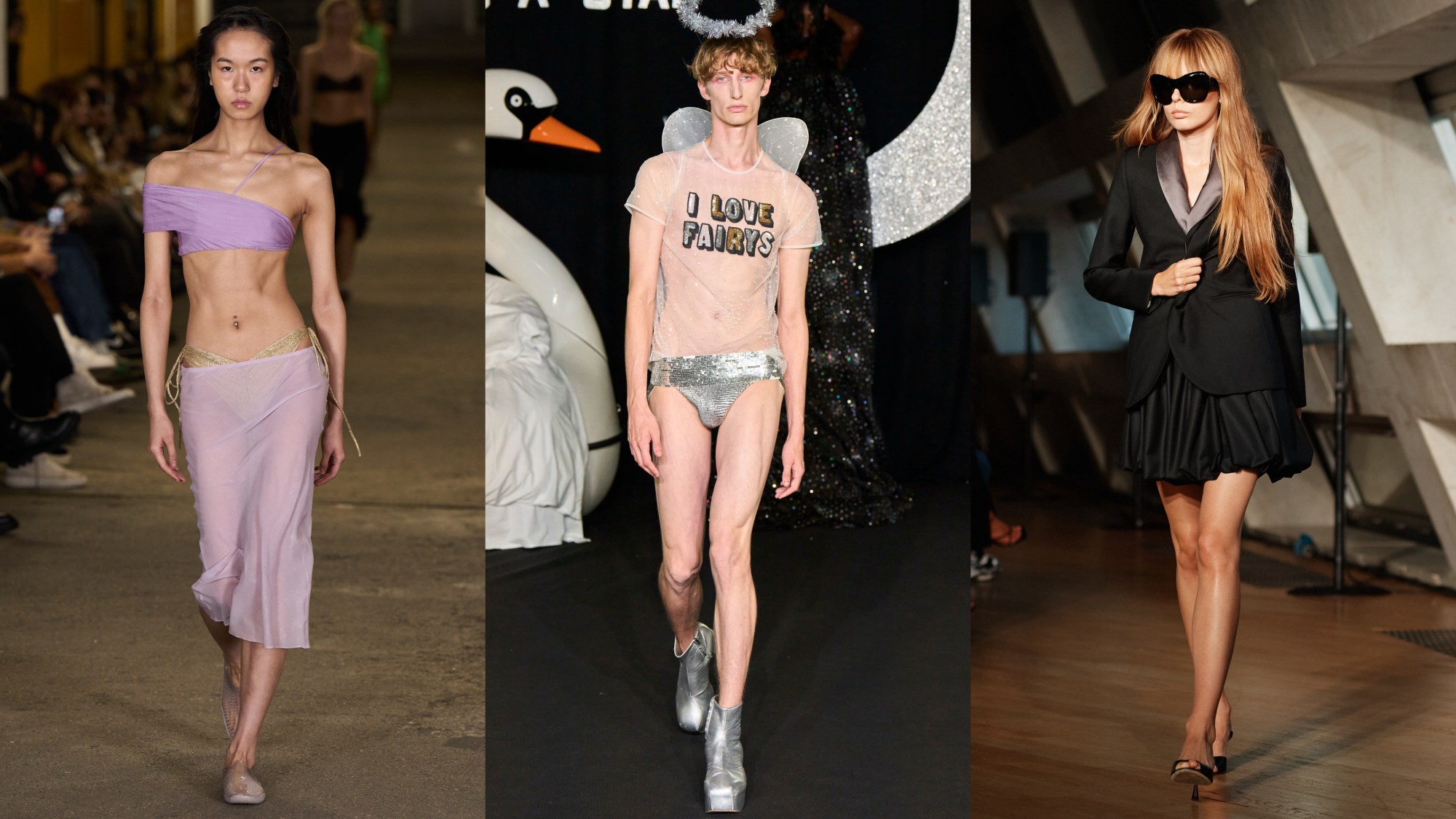London Calling! The fash pack have hopped across The Atlantic, bringing the SS24 season from The Big Apple to The Big Smoke and it’s set to be a good one! There’s the return of cult faves Supriya Lele and Ashley Williams at Fashion East, as well as Stefan Cooke after a well-deserved season away. One of the city’s most exciting young menswear designers, Aaron Esh, makes his runway debut whilst Skepta launches his streetwear brand MAINS with a highly-anticipated DSM collab. On top of it all, we have new collections from many of our faves: JW Anderson, Chopova Lowena, KNWLS and Sinead O’Dwyer to name a few, and we’ll be covering them all! Keep this page bookmarked for everything London Fashion Week.
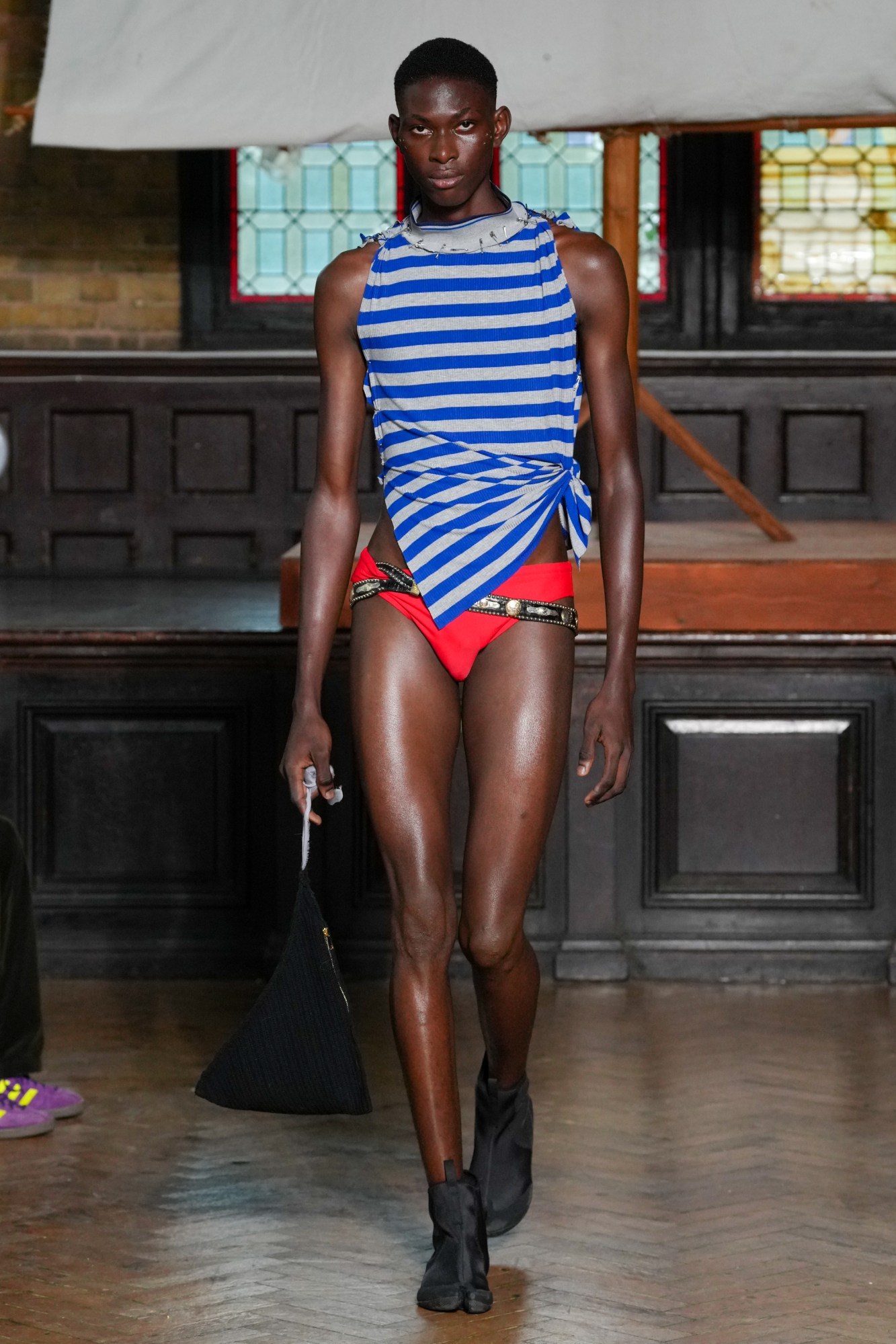
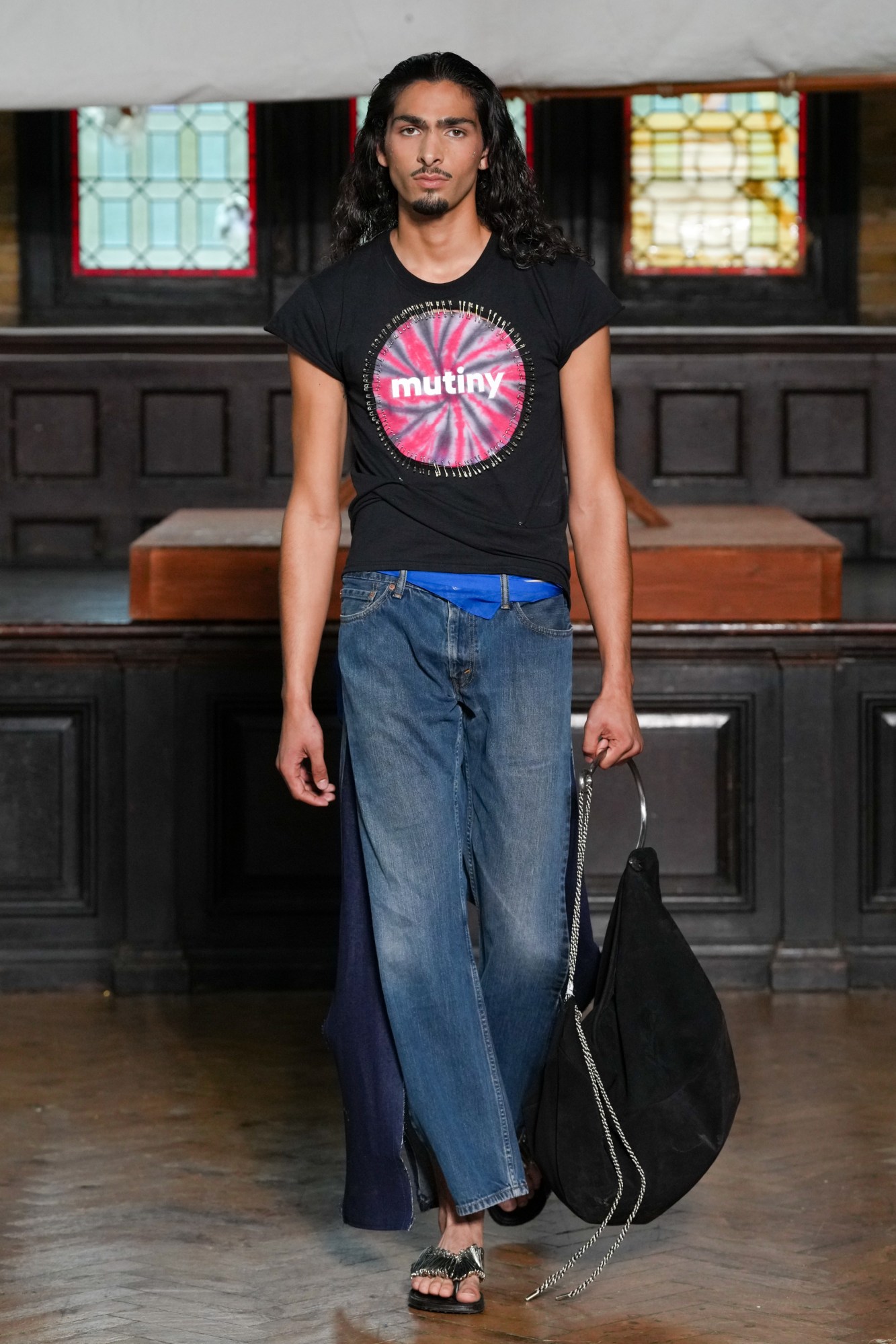
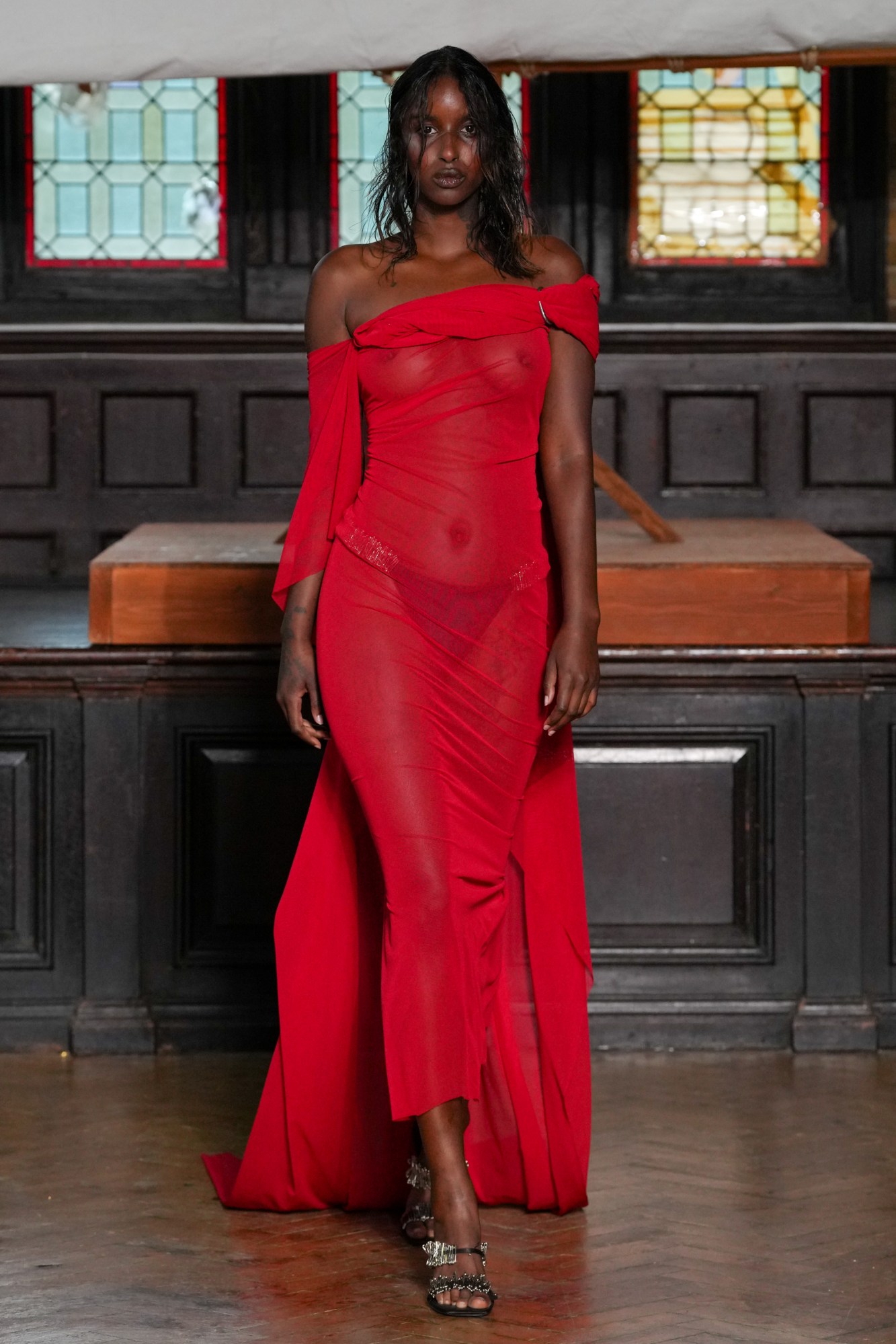
Jawara Alleyne
In the wake of the US senate relaxing its dress code to allow shorts and hoodies on the chamber floor, Jawara Alleyne created a collection perfect for their new work wardrobes. “I was pulling from my time working at a bank on the [Cayman Islands] and dreaming of a wardrobe that presented an ease in such a hot space. I would often get sent home for wearing garments which were appropriate for the weather but inappropriate for the corporate environment.” the designer said about the collection, one worked on largely while visiting his home islands of Jamaica and the Caymans for the first time since 2019.
“Beach Business” plays on the mid-way between workwear and beachwear, a concept that feels increasingly prescient as global warming makes summers increasingly difficult times during which to focus when wearing stiff shirts under wool blazers and restrictive neckties. Garments are made from light and loose materials, then deconstructed or slashed along the sleeves to make them more breezy. Knitwear features rib cage cutouts and tops are pulled away from the shoulder or the neck, as if to allow the wearer to air their body out, then paired with swim briefs in summery, carnival hues. A collaboration with Mutiny, a Caymanian streetwear brand that left Jawara inspired for having seen another label hailing from the islands with a rebellious, punkish edge, saw patches heavily safety pinned to tees (safety pins too were piled onto strappy sandals and the thongs of flip-flops). The final few looks paid homage to both luxury resortwear and the style of the women within Jawara’s own family, as coverups in sheer fabrics were cut like eveningwear and sarongs and bandeaus were fashioned from towelling materials. Here, Jawara questioned notions of glamour, beauty and acceptable attire on a planet that is increasingly heating up and clothes become increasingly uncomfortable. Will turning up to the office in swim briefs become the new norm? Will our party dresses be able to soak up sweat at the same time? At least, with Jawara behind this new style frontier, it will still be chic. TG

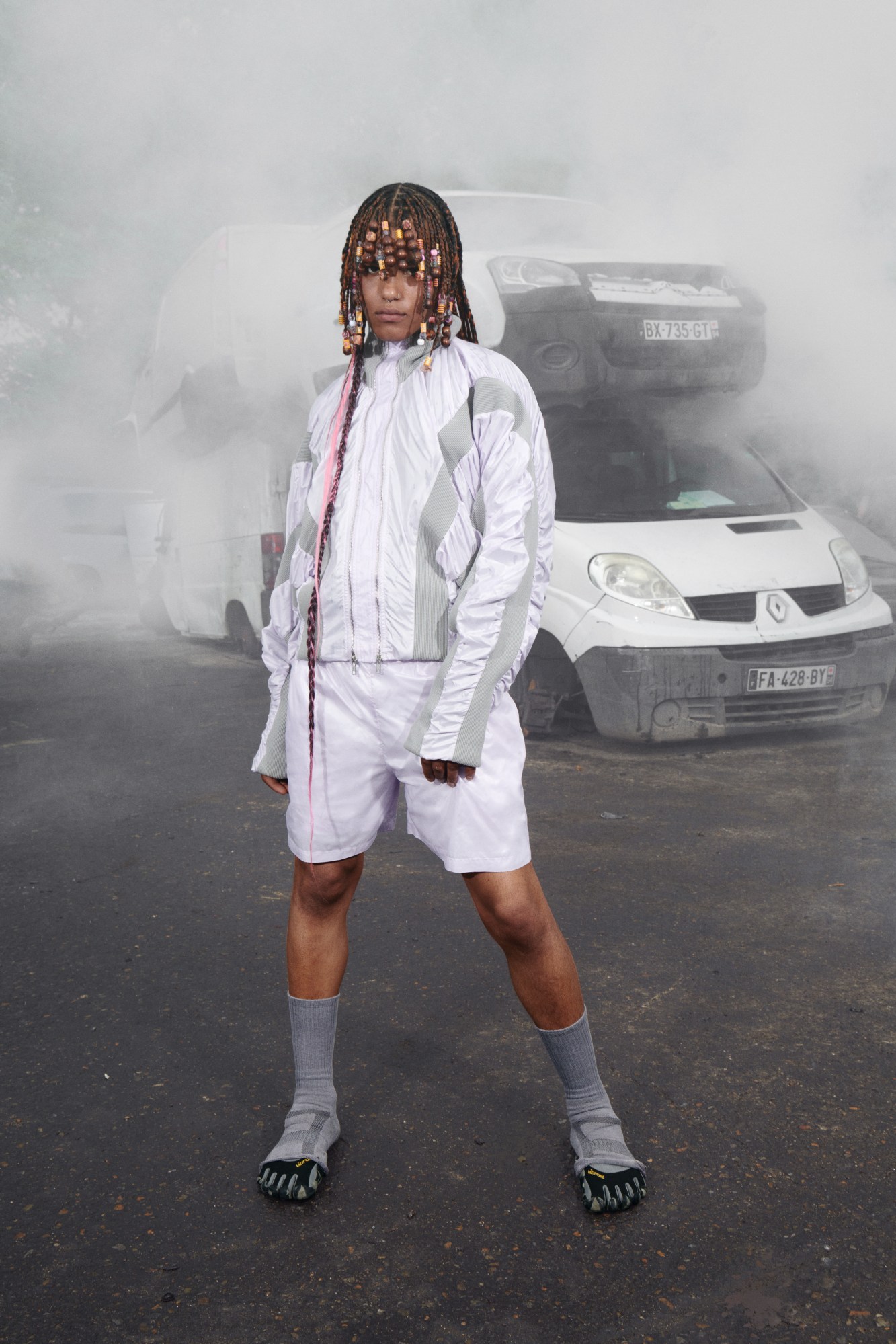

Lueder
Every now and then, while riding the steaming helltrain that is neoliberalism, we’re offered a glimmer of hope. One of those very glimmers is the designer Marie Lueder, the Hamburgian designer bringing her salvaged eleganza to London’s fashion sphere. Indeed, her designs marry a trained hand in traditional tailoring with a uniquely DIY sensibility that splices late-capitalist detritus into the most polished version of crust-punk we’ve ever seen.
For SS24, it’s business as usual. Hoodies, ribbed at opposing angles, become retro-futuristic balaclava jackets, shrouding the neck completely and teaming with meandering hem, marl sweatpants, laced across the crotch like a corset. Cosy, sure, but ready to do battle. Elsewhere, sleeves are sliced raw from zip-up jackets, with exposed hems across the waist and the now signature double zips. Such sporty elements find their foil in crisp shirting, patchworked in monochrome panels as if to say that even when shit hits the fan, you can still look chic.
If anyone lives by the make-do-and-mend policy, it’s Marie. Even her repurposed satin bomber jackets are lined in gently curving grey ribs, inducing a light gather across the arms and the shoulders. As for the bonnets, designed in collaboration with artist and designer 4FSB, these serve the same mediaeval energy we have known and loved in Marie’s work from day dot. Adorned with zips along svelte lines, they’re everything your modern-day rave crusader needs.
Look closely, and you’ll pick up on the tightly seamed leather patchwork pants, so neatly finished they appear bonded rather than sewn. On top, darkend rust dyed denims, complete with a twisted fly. Among them, a trend for Armageddon-ready athleticism holds court – also mirrored in the campaign’s settings. Burnt out lorries and cars steam in the background as if the whole of society has finally imploded, leaving us no option but to joyride through the embers. Sure, it’s dark, but what’s a girl to do when everything’s in flames. JB
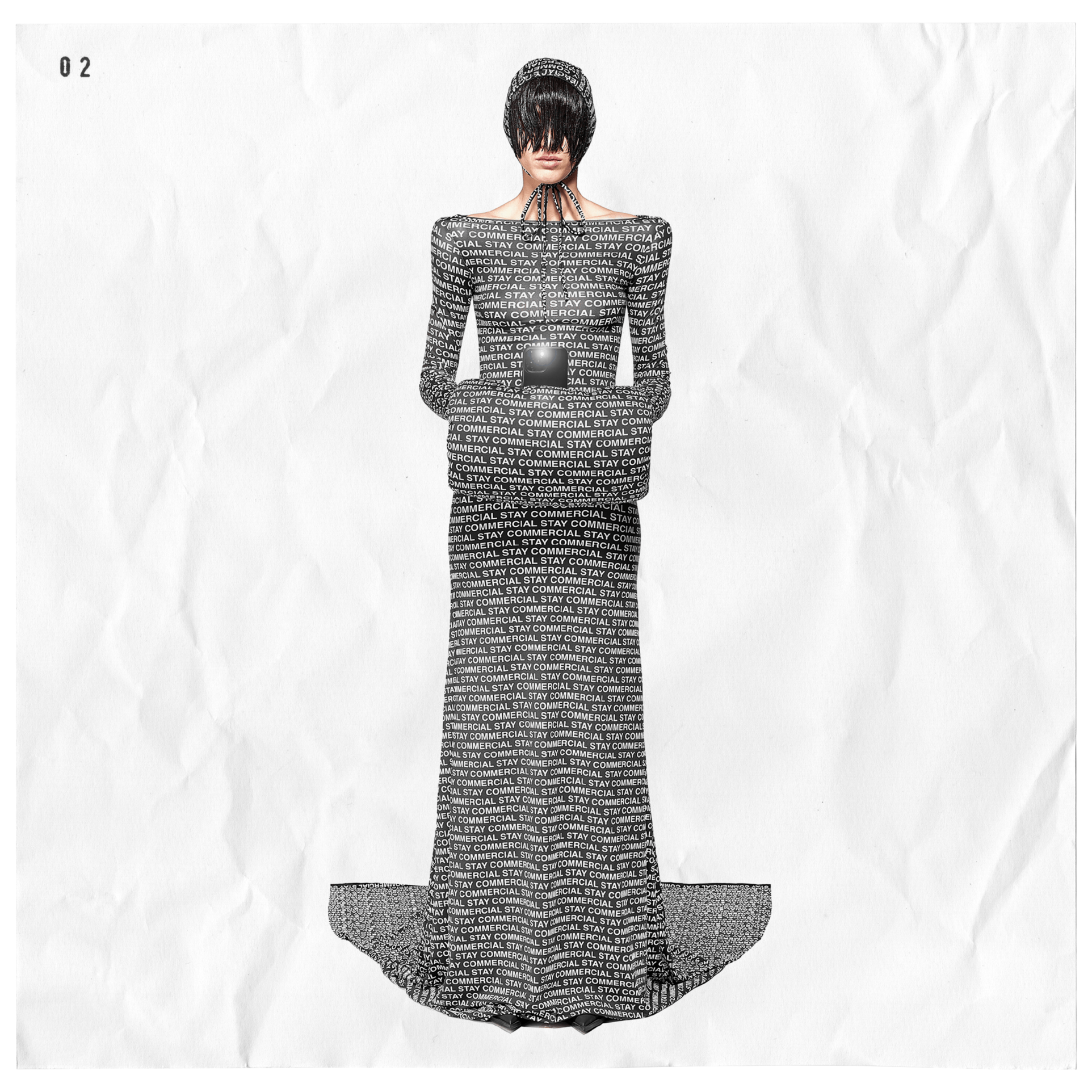
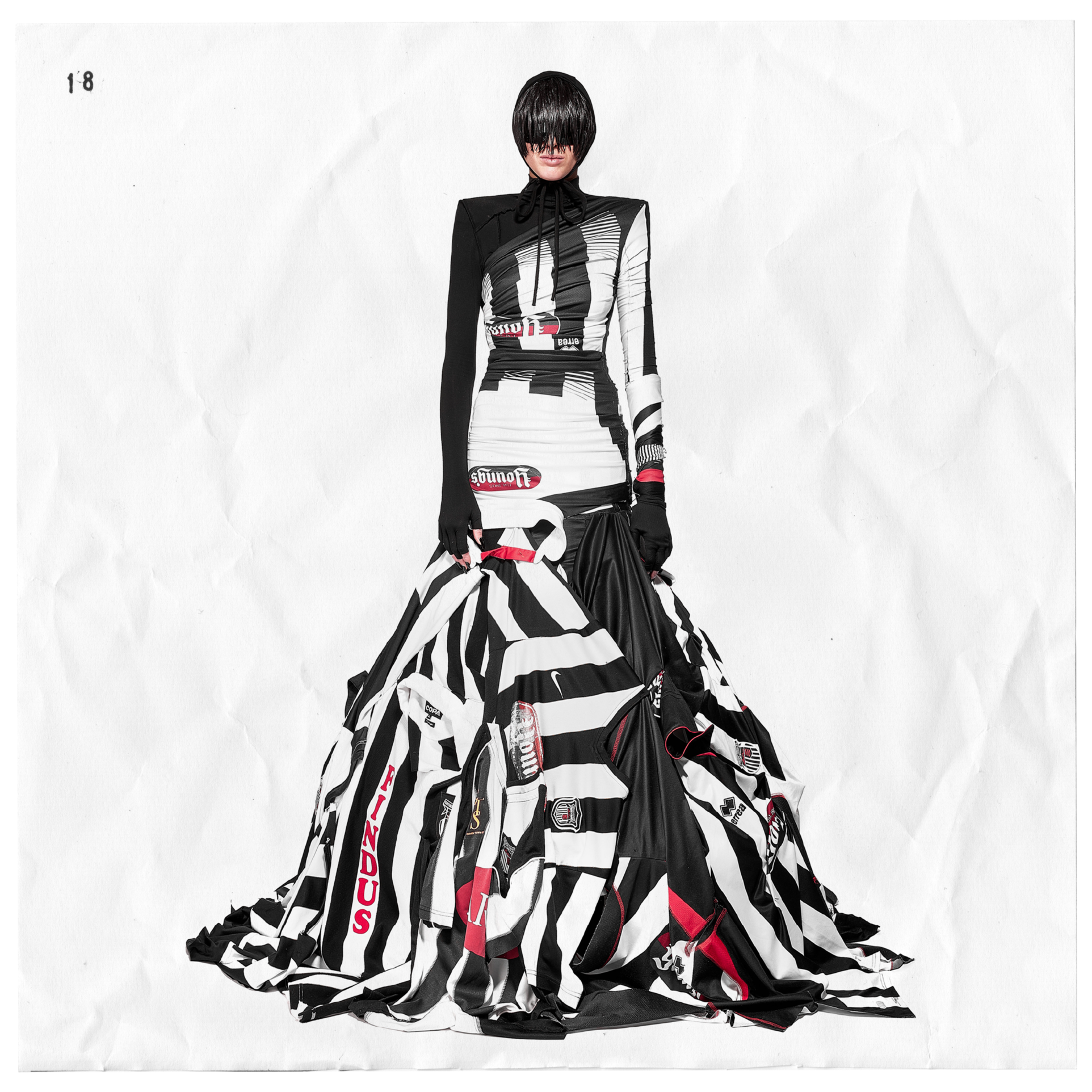
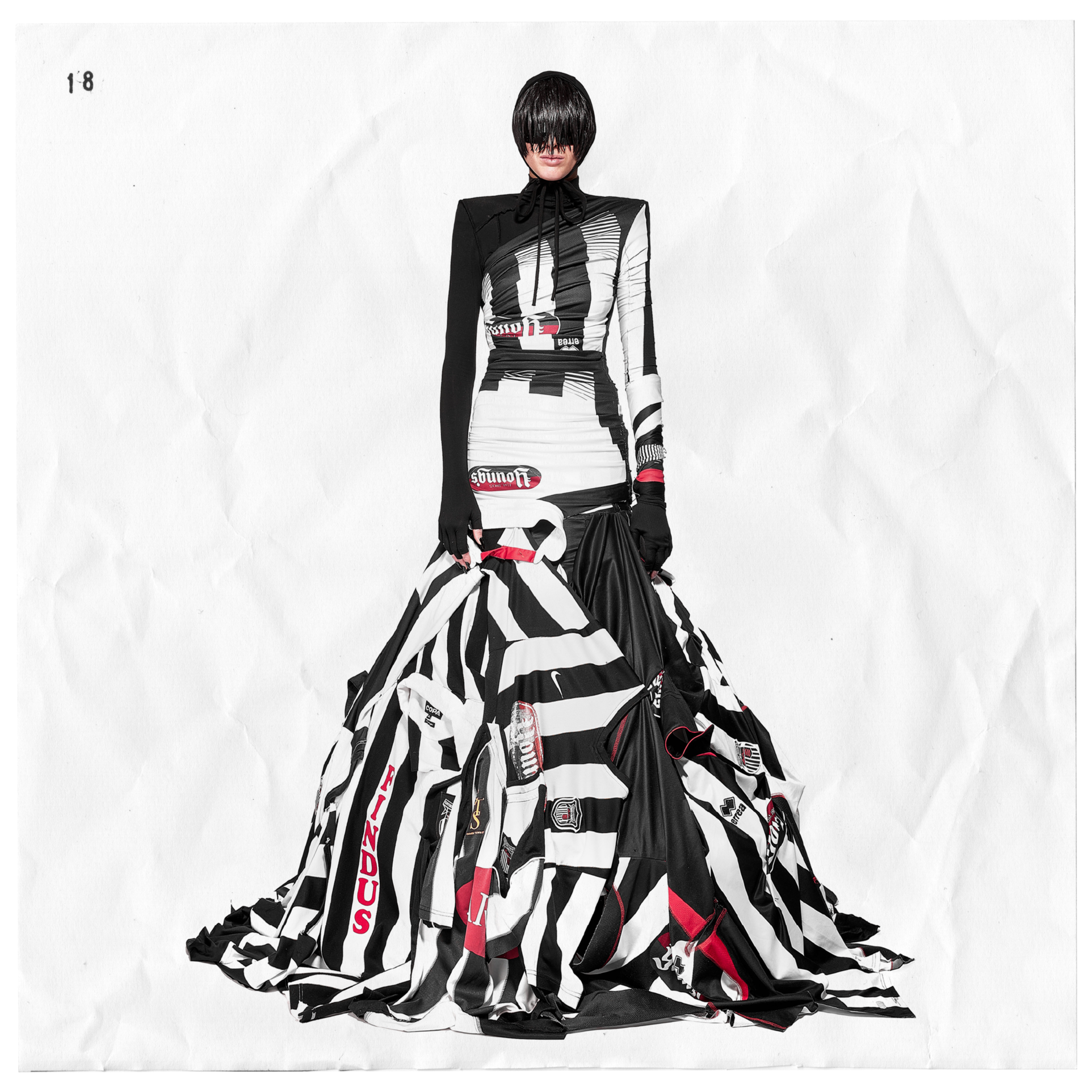
Betsy Johnson
Fashion and socialism have never been the best of friends, and no one knows this better than Betsy Johnson, the Grimsby-born designer whose fiercely political approach to creative direction and styling has now evolved into out-and-out collections. Exhausted by art school students cosplaying as proletariat wunderkinds, the Northern designer flips the social dynamic, serving up a campaign that looks rich. “The whole collection is a conversation about mid-inflation survival, the ever-widening wealth gap and our youths only survival technique: clothing as armour, class identity camouflage – all in everydaywear and partywear,” explained Betsy.
Shown in an eerie shoot across her hometown and an ingenious film where looks pass by on a conveyor belt, the collection is peppered with jibes and commentary, from the ‘SALE’ swing-tag patches, tiled ‘Stay commercial’ prints and the kind of silhouettes you’d expect from a 70s Cristóbal Balenciaga collection. Svelte and imposing, Star Wars-esque tunics are sharpened at the shoulder and sliced with diagonal leather panelling and the heavy-duty utility belt you’d expert of a Sith lord – only, it’s embossed, again, with ‘SALE’. Leather boots splay outwards, while dresses come in eco-leather, complete with puffball cushion accessories that join the two hands like a curtseying lady. A little bit gothic, brooding and totally unwavering in its message: we are all but commodities, playing dress-up while the neoliberal overlords watch us float past like snacks in a deli.
It’s a brave entrance into Planet Mode. Attacking the protocol to self-brand – especially prescient for working-class creatives for whom paychecks are more than a cute bonus – is, nonetheless, an urgent and worthy cause. Here, the homo economicus comes into full view, priced up and ready to solicit its services to any willing corporate monolith.
Elsewhere, nods to Betsy’s past appear in Grimsby Football Club carrier bags and a regal frock designed using upcycled football strips. Set against leather office skirts and shrouding, turtle-neck jackets, which hold the arms to models’ sides in prim but proper poise, the work feels especially charged. 16th-century bonnets, splashed in that kitschy ‘Stay commercial’ print are the icing on the cake. If Marx never had time for fashion, it’s because he hadn’t met Betsy. JB


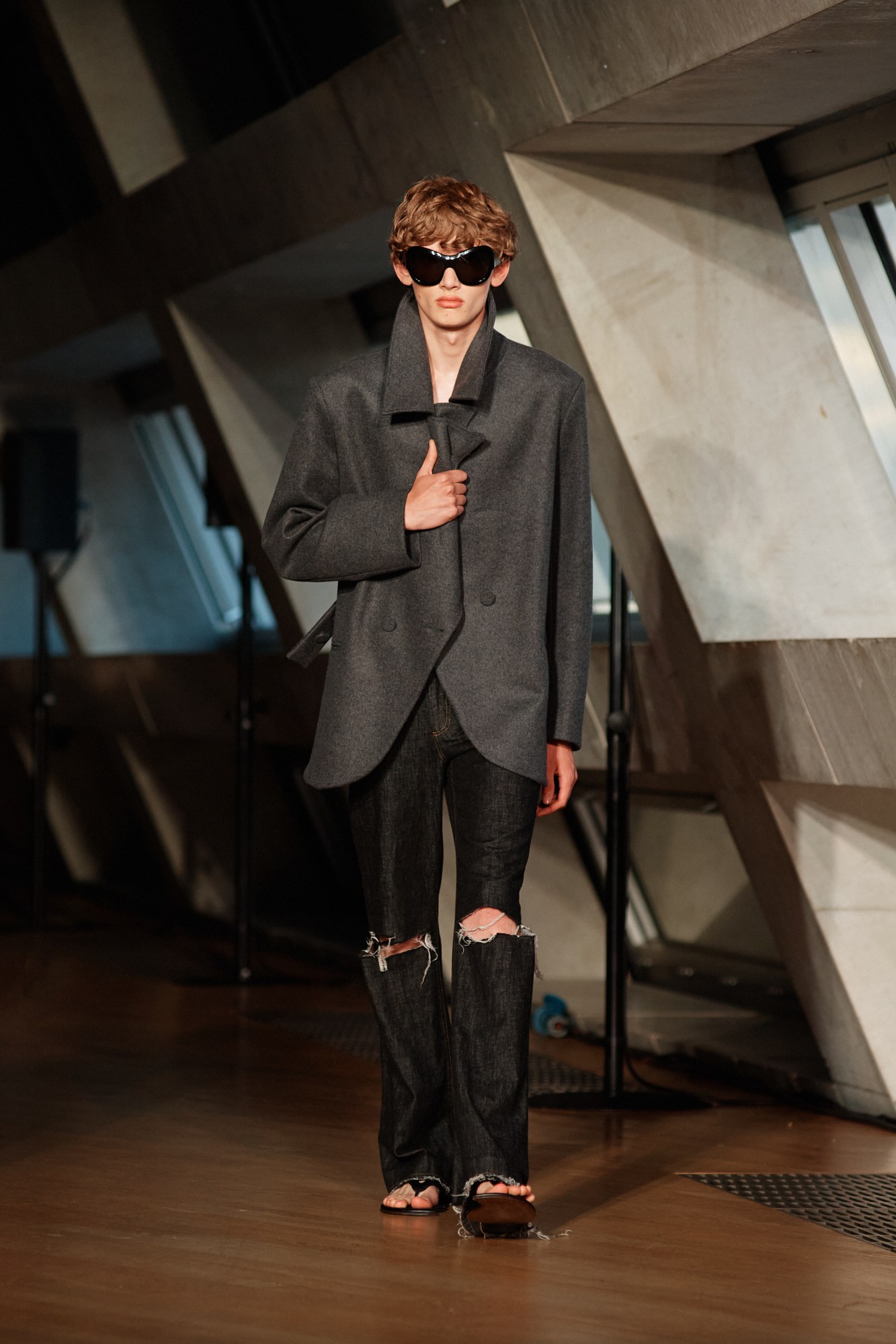
Aaron Esh
There was a lot riding on Aaron Esh’s runway debut. Having already bagged himself BFC NEWGEN support and a growing list of buyers, he would deliver not just a taste of what he’s about, but a necessarily cohesive collection that’s as commercially viable as it is chic. Fortunately, the East London boy came good, presenting his own vision of occasionwear that emanates from the streets upwards.
Held in the lofty halls of Tate Modern, the show felt immediately serious, inducing a unanimous sense of calm and focus among guests with a brooding soundtrack akin to the grey noise of a nightbus. Filing down the runway, his boys came with sharpened tailoring (and cheekbones), cut to slip across the thighs before widening in a light bootleg. Beneath the satin, his now signature comma derbies had morphed into buttery split-toe sandals. This loose but louche sensibility was later flipped, manifesting instead in undersized dinner jackets, finished with only two buttons and a baby lapel. His cool restraint did come with flourish, though. You just had to look for it. A cowl neck, lightly gathered across the men’s décolletage, and fluttering silk scarves draped from the neck were a case in point.
It’s true: Aaron has grown tired of his characterisation as a gender-bending designer. This is not about dissecting binaries in his eyes, rather a purely formal exercise in beautifying tailoring – a method born from menswear, but just as applicable to womenswear, too. Little wonder, then, that he chose his debut to air an extensive womenswear range, enrobing his girls in the bubble-hemmed skirts he had once used on the boys, while also slipping them inside supple tux jackets, primed with contrast lapels in gossamer champagne.
Elsewhere, ladies tweed suits, cut short of the wrist, were dotted with poplin and a miniature collar, training the eye towards Aaron’s impeccable sense of balance and symmetry. Between those, tunic suit jackets – opening precisely at the navel – and the splayed collar bombers, which upturned at the waist by some ribbing trickery, lies a fil rouge for polish and precision. “Every single detail, from the make of the clothes to the make-up was curated,” said Aaron post-show. “We want to present this idea of elevated luxury from a real point of view, not an aristocratic world.” Indeed, Aaron adores the luxury world aimed at lords and ladies, but sees it as his responsibility to root his luxury offering in London grit. Forget stealth wealth; salt of the earth elegance is taking over. JB
Burberry
Yesterday afternoon, Burberry invited guests on a damp walk through leafy, residential Highbury Fields, far from the usual show venues of London Fashion Week. Although the local dog walkers have been put out by weeks of the park being cordoned off, guests were delighted to be welcomed to the festival-like tent venue with cups of tea, hearty Eccles cake and slices of Guinness bread — a right ol’ English welcome following a week of very Bri’ish activations for the brand (national treasure Mary Berry in a campaign, a much-talked -bout pop-up greasy spoon café, the transformation of Bond Street station as ‘Burberry Street’ to celebrate a newly re-opened store). Whether you’re in fashion or just an ordinary Londoner taking the tube and perplexed by all the Burberry branding, you get the sense that Daniel Lee and the powers-that-be are going all out. Burberry is back and staking its claim on Old Blighty, its global USP. Read our full review here. OA
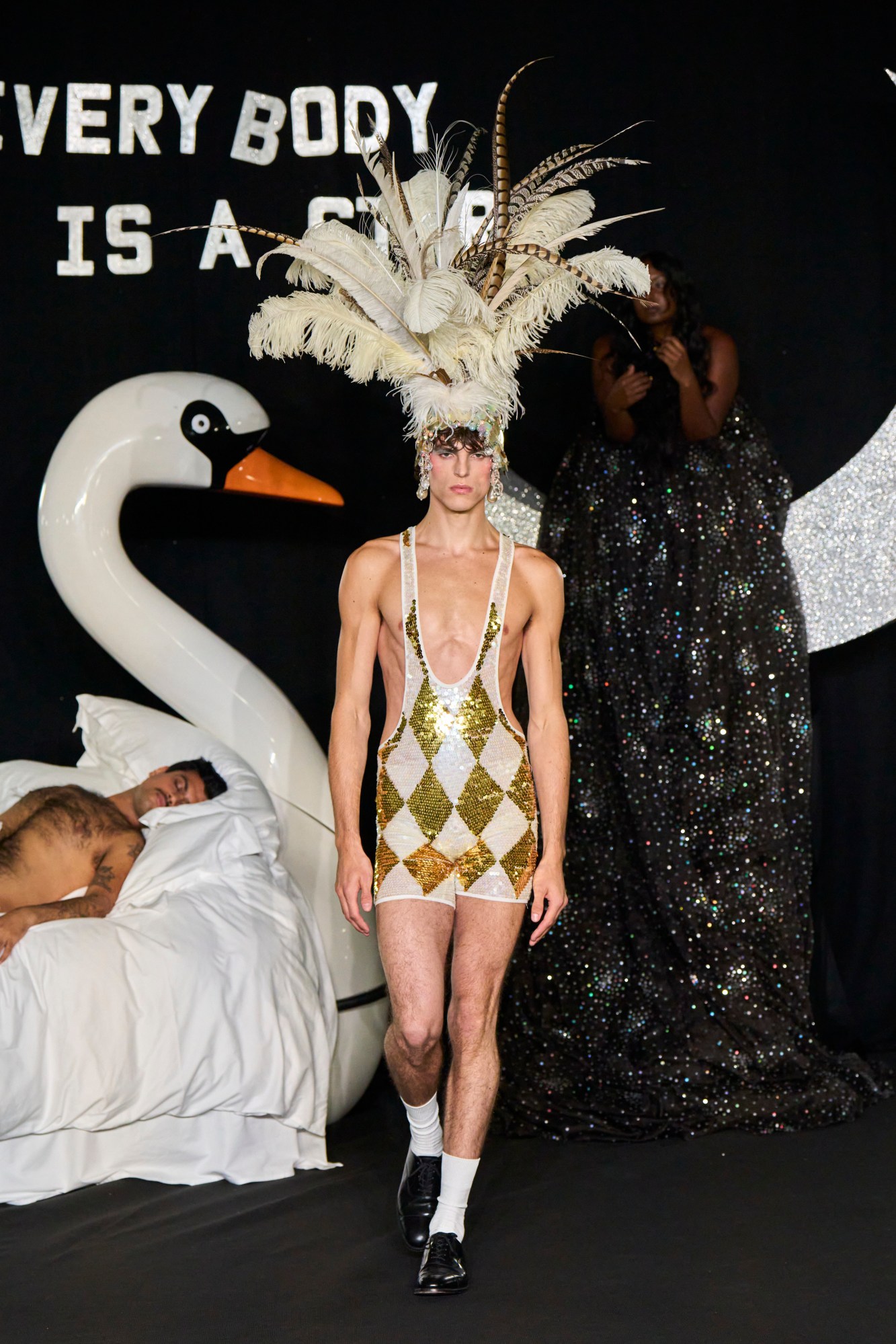
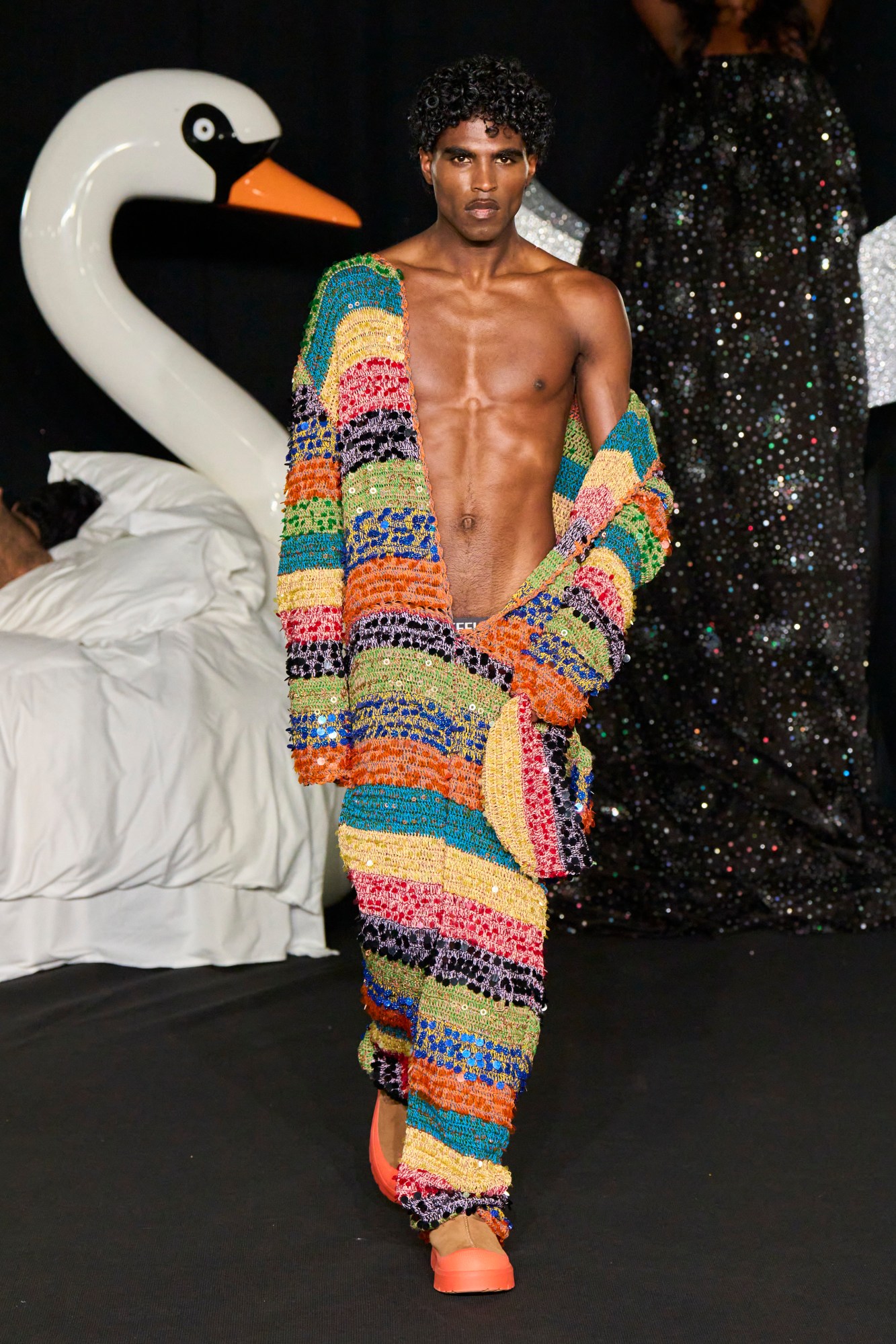

Ashish
Returning to the runway after a three-year hiatus, Ashish Gupta put the show in show, envisioning a surrealist cabaret, replete with jazz-handing showgirls, sequinned budgie smugglers and the tongue-in-cheek sloganeering he’s built his brand upon. On the heels of his retrospective exhibition, Fall in Love and Be More Tender (2023), at the William Morris Gallery, this overdue outing delivered a similar message, fighting doom and gloom with opulence and high camp.
For the occasion, Ashish appointed a one-off creative director, Linda Stirling, the radical feminist collagist. Between them, they settled on the theme of dreaming. “I remember Louise Wilson used to always say to me at [Central] Saint Martins, ‘Dream, because if you don’t fucking dream, what are you going to do?” said Ashish backstage. Citing the refugee crisis and the intermingled oppression of queer people – two issues that affect him directly – he spoke with urgency but defiant optimism.
As such, Ashish briefed the models with a gamut of buzzwords – “fantasy”, “sex-positive”, “body positive” – all of which ensued. A soundtrack pronouncing, “I love dick in the morning and in the evening,” found its sartorial counterpart in the silver paillette jockstrap and sheer t-shirt emblazoned with “I love fairies”, while a salmon fishnet dress was teamed with only a bikini and chrome heels. Elsewhere, a Chanel template tweed was harlequinned in Tetris blocks of carrot, Little Mermaid blues and gilt lining, finished with a red lip and beehive pompadour. A nod to the late Amy Winehouse, whose 40th birthday was just days ago? Perhaps.
Casting-wise, this was a show of characters, each one encouraged to flounce or frolic as they deemed appropriate. One elderly model, clad in a hot-pink tiger two-piece waltzed her way through the meandering catwalk, while one platinum drag queen carried herself in elaborate strides, sluiced into a candied office jacket and mini-skirt. There were 90s goths – still glistening despite their black bikers – plus a chokered art school girl, patchworked into a beaded camisole with a blushing love interest, himself decked in intricate gems, a wire-ribbed sweater vest and customised UGGs.
Ashish might be dreaming when he renders such looks, but they’re all rooted in reality, just embellished – or sequinned, to be precise. Even floral dresses, otherwise the refuge of stylistically resigned suburbanites, beamed when their petals were given the Ashish treatment. In many ways, the sparkle-pantied sleeping go-go boy tucked in bed at the front of the runway embodied Ashish’s enduring message. Fantasies are only a good night’s sleep away. JB
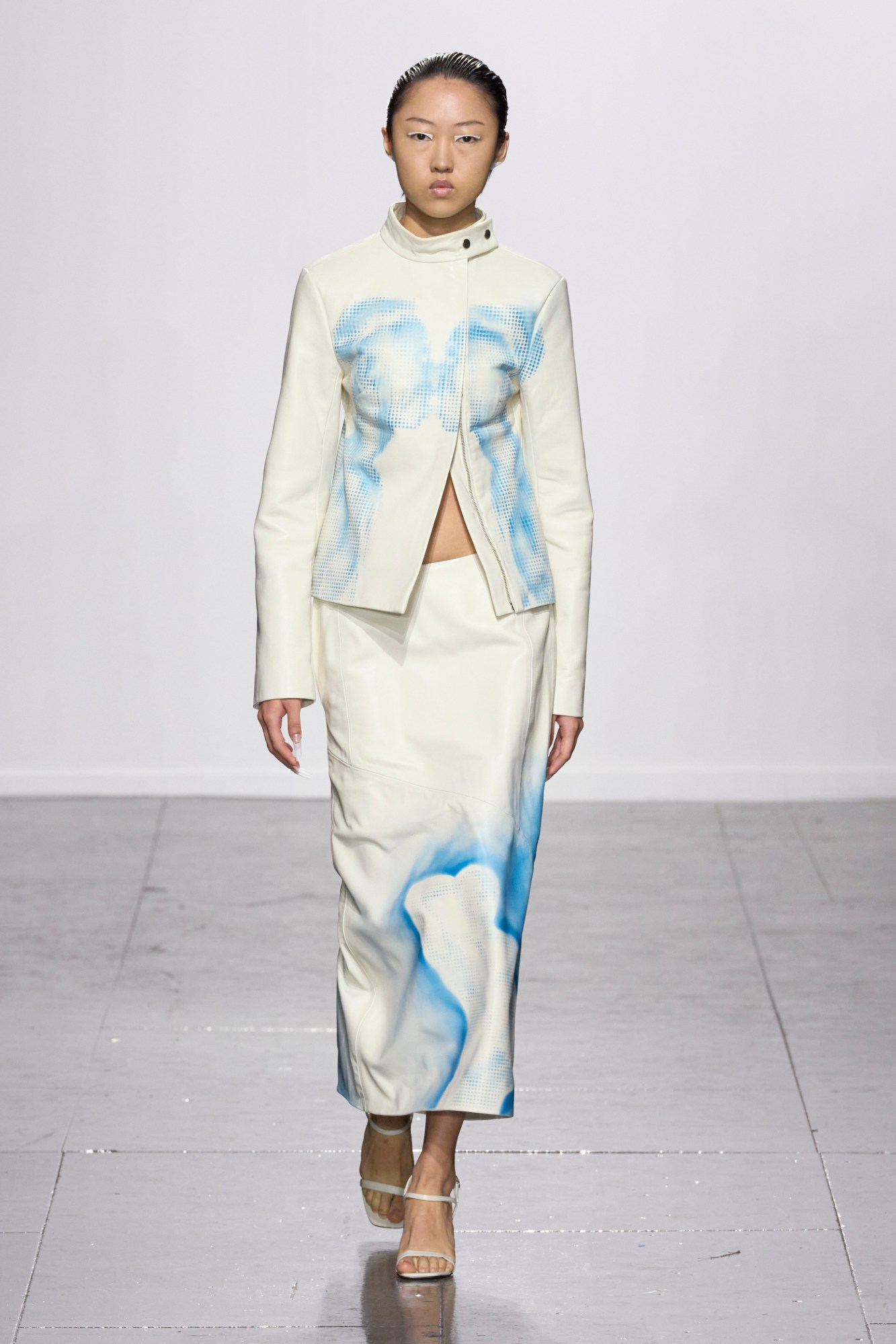
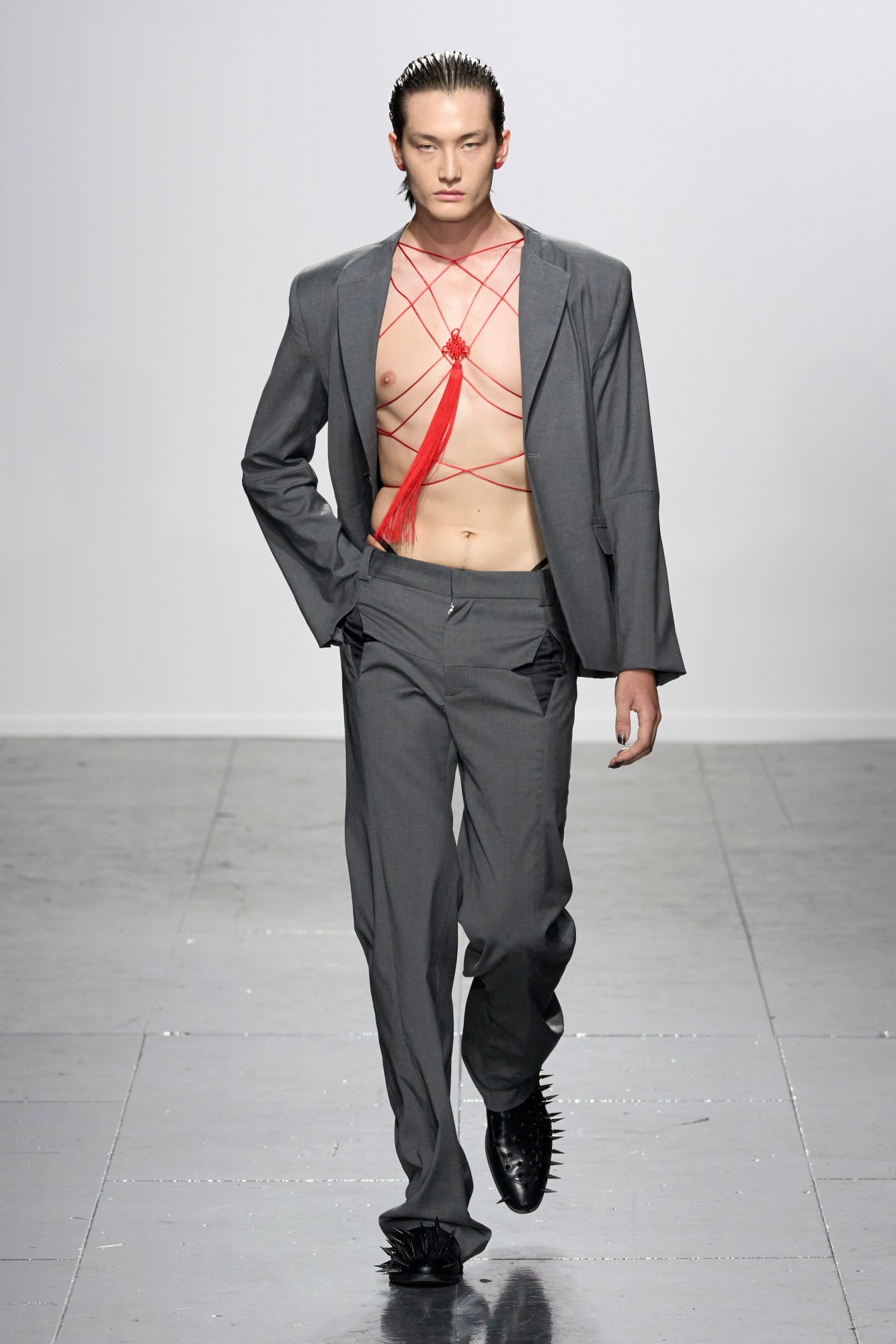

Chet Lo
Many Asian people in the West have spoken about the impact a white, heterosexual gaze has had on their sexuality, finding themselves either fetishised or desexualised. Additionally, a taboo amongst the older generations around sex, let alone queer sex, has often filtered down into a shame of those desires within the next generation. Such feelings of desexualisation and shame were the personal experiences that Chet Lo drew upon for SS24, presenting a collection that looked to heal those wounds by celebrating queer East Asian sexuality.
After opening with a virginal white leather strapless top with matching trousers, the knees of which had stars slashed into them like they had become tellingly torn during moments of passion, what then followed were collarless jackets and unbuttoned office white blouses printed with abstracted depictions across the chest of two men inches away from their lips meeting. Elsewhere, slinky, silky gowns and the kind of mesh tops you’d see a jock storming around Fire in Vauxhall in were printed with shunga, the erotic Japanese art that was celebrated during in the Edo period but later shunned. Unassuming suit blazers were left open revealing an intricate wrapping of bondage ropes – known as shibari, a japanese form of erotic play that is also used for meditation. These then came together to form Chinese knots that symbolise luck, here resembling a work tie, or dangling from the g-string cut outs on flared trousers.
As the collection progressed the formal workwear became increasingly clubby, with higher hemlines, shorter sleeves and more waist on show as Chet’s signature protectively spiked fabric formed baby tees, vests and a thong, the wearer rebelliously going out for the night in the sexy clothes they want to wear, regardless of what their parents will say. This finally culminated in a model walking onto the runway in a sheer skirt over skimpy underwear and a revealing halter top made from the knots of stringy erotic rope; a look that brought the collection to wear Chet is today with the bold sexuality in his brand. TG
Supriya Lele
Where has Supriya Lele been, you might have been asking? Well, the British designer has been busy during her hiatus from the runway. In May, she ventured into the art world, taking over the former pharmacy beneath her studio in Southwark to open the Qrystal Partners gallery alongside curator Donald Ryan. And just last week, she was in New York, following months of working on a special collection for the newly revamped Victoria’s Secret, adorning its angels in marble-inspired drapery fit for a Greek goddess. It’s provided ample momentum for what many have framed as her fashion comeback (although she never technically hit pause on her business): a return to the LFW schedule with a standalone show heralding a new chapter for her namesake line. You see, Supriya has grown up since her Fashion East days — no longer one of London’s young rising stars, she is ready to declare herself a Big Girl designer, with an ardently loyal, far-reaching community of women who adore her designs. Read our full review here. OA
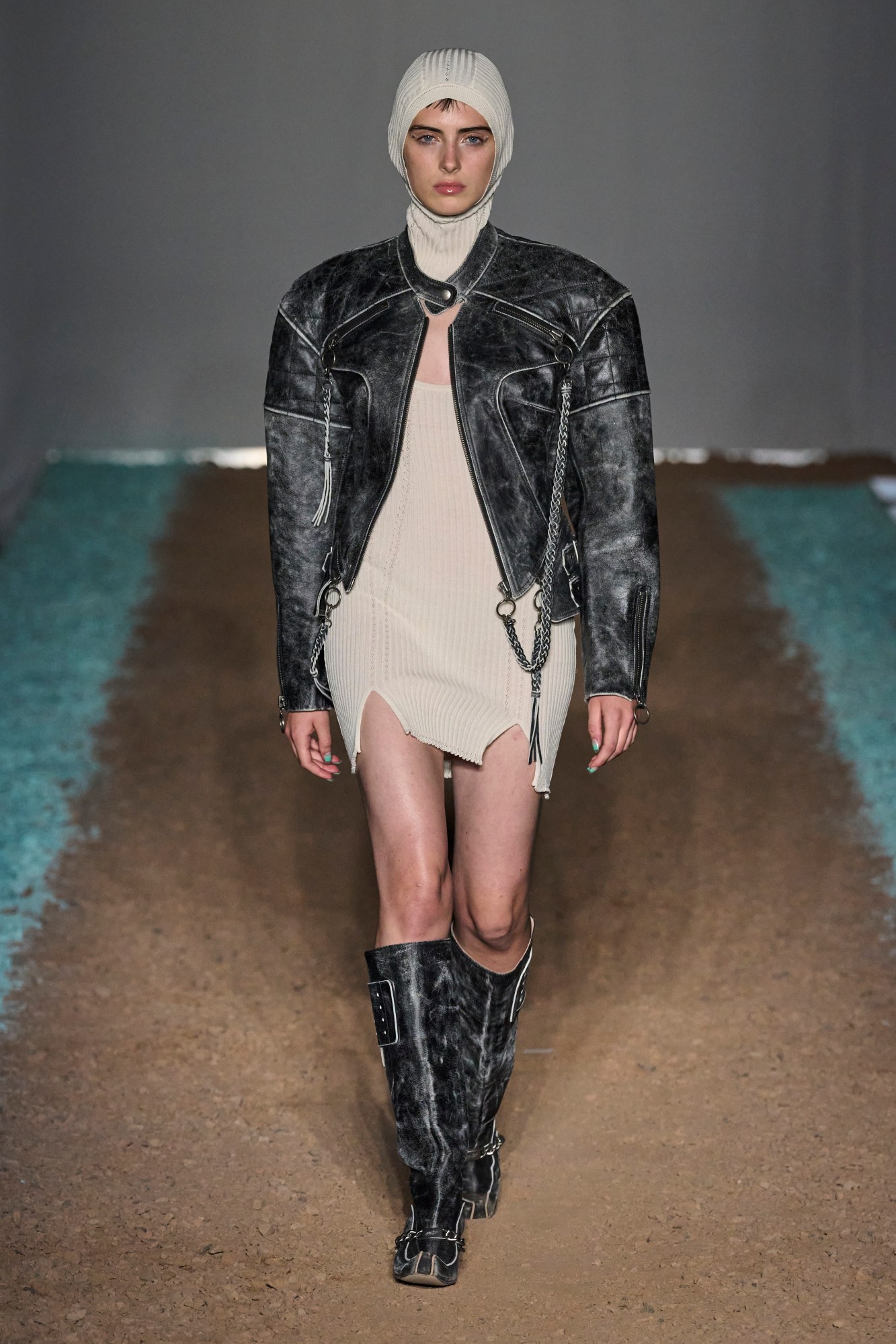
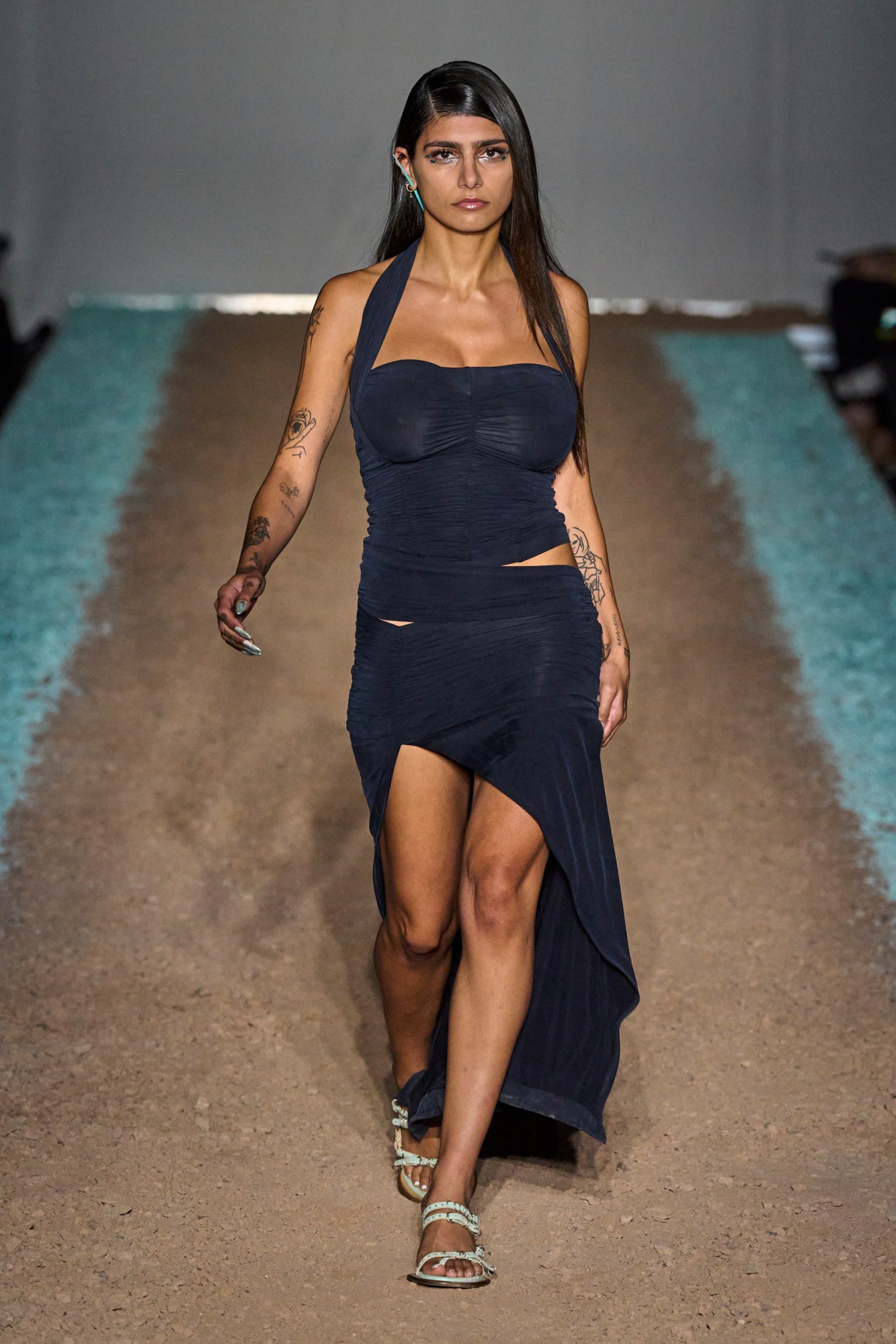
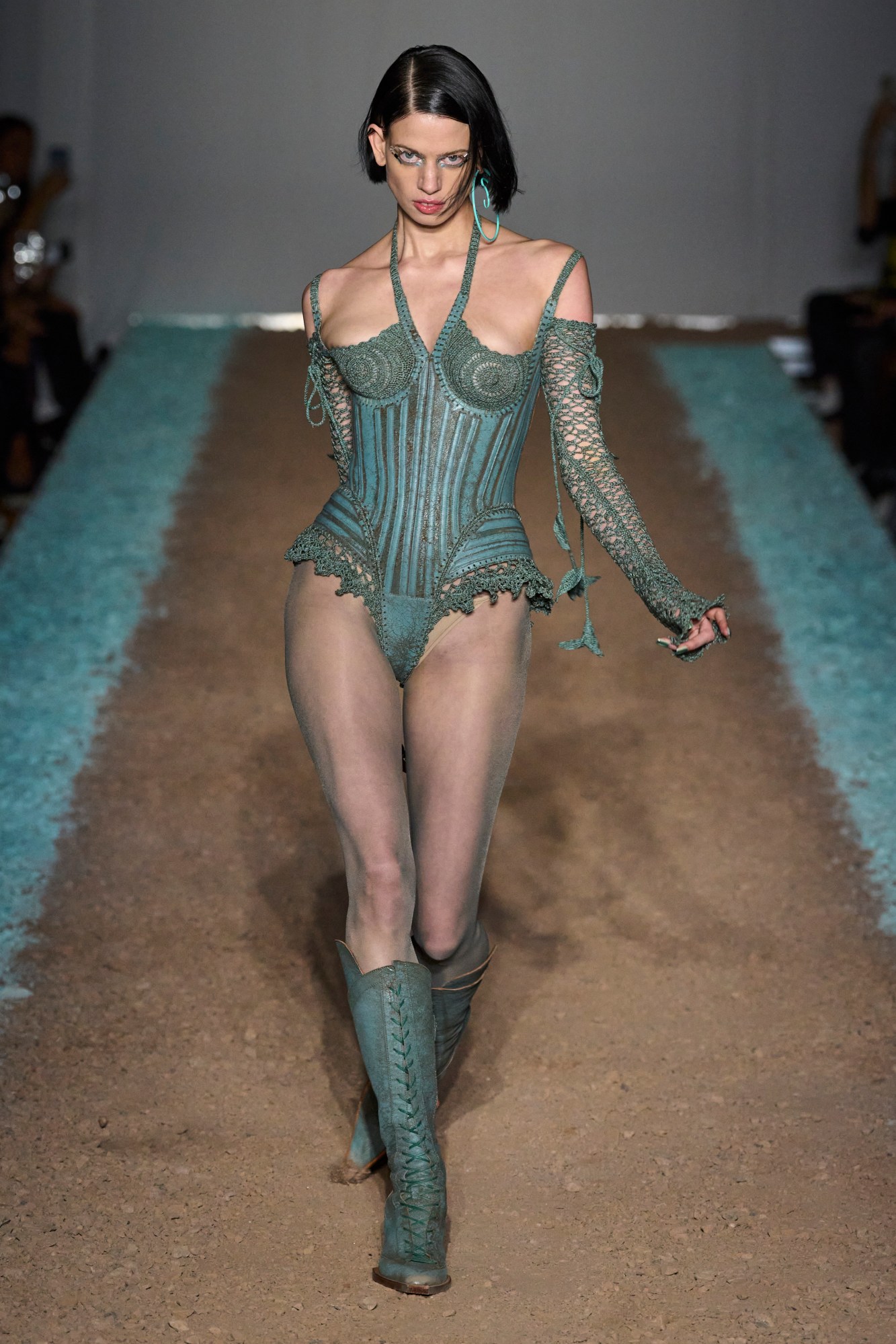
KNWLS
After stepping back from the calendar last season, last night saw KNWLS, one of the city’s best-loved independent womenswear talents, make a triumphant return to the runway to present Petrol — an expectedly high-octane, pedal-to-the-metal ride of a collection.
Reiterating the signatures that the brand has established since its founding in 2017, this season saw Charlotte Knowles and Alex Arsenault double down on the exquisite leather treatments that have become a hallmark of KNWLS’ rough-and-ready, uncompromisingly feminine aesthetic. Linebacker-shouldered coats with nipped-in waists, low rider trousers and fitted moto jackets came in abraded, grease-streaked bull hide in black and teal, with the same texture also decorating eminently desirable knee and thigh high biker boots, not to mention new iterations of the brand’s curvilinear Razr and Fang bags.
The motomami energy of it all was compounded by the sense of speed and movement conjured by braided pull straps and chain details that jangled and flickered with each model’s jolt down the runway, as well as by a suite of slashed-and-strapped-together shirts and skirts in plaid-print mesh, a nod to vintage Harley Davidson flannel shirts. Tendrilous blouses flickered like petrol-fuelled flames, and draped dresses with hip cut-outs and thigh-high slits — as worn by Mia Khalifa — came in slick, oil-sheened cupro in navy and coral.
Beyond the familiar KNWLS tropes, though, this season also brought a suite of looks imbued with couture-level detail — midi dresses in chequered chiffon were fully-fringed with beading that exactly replicated the underlying pattern, while webbed, seemingly threadbare gowns were made from strings of glistening black glass beads. Perhaps the most breathtaking moment among the show’s line-up of hits, though, was the crowning piece from KNWLS very recently launched — and much buzzed about — collaboration with Jean Paul Gaultier: a painstakingly crafted, teal leather corset with crocheted sleeves, bust cups and fringing. Flaunted by Lily McMenamy, the British-American model stormed the runway with a deliciously camp walk to JPG’s 1989 track “How To Do That” — fitting, given that, with this collection, KNWLS showed us all just how. MS

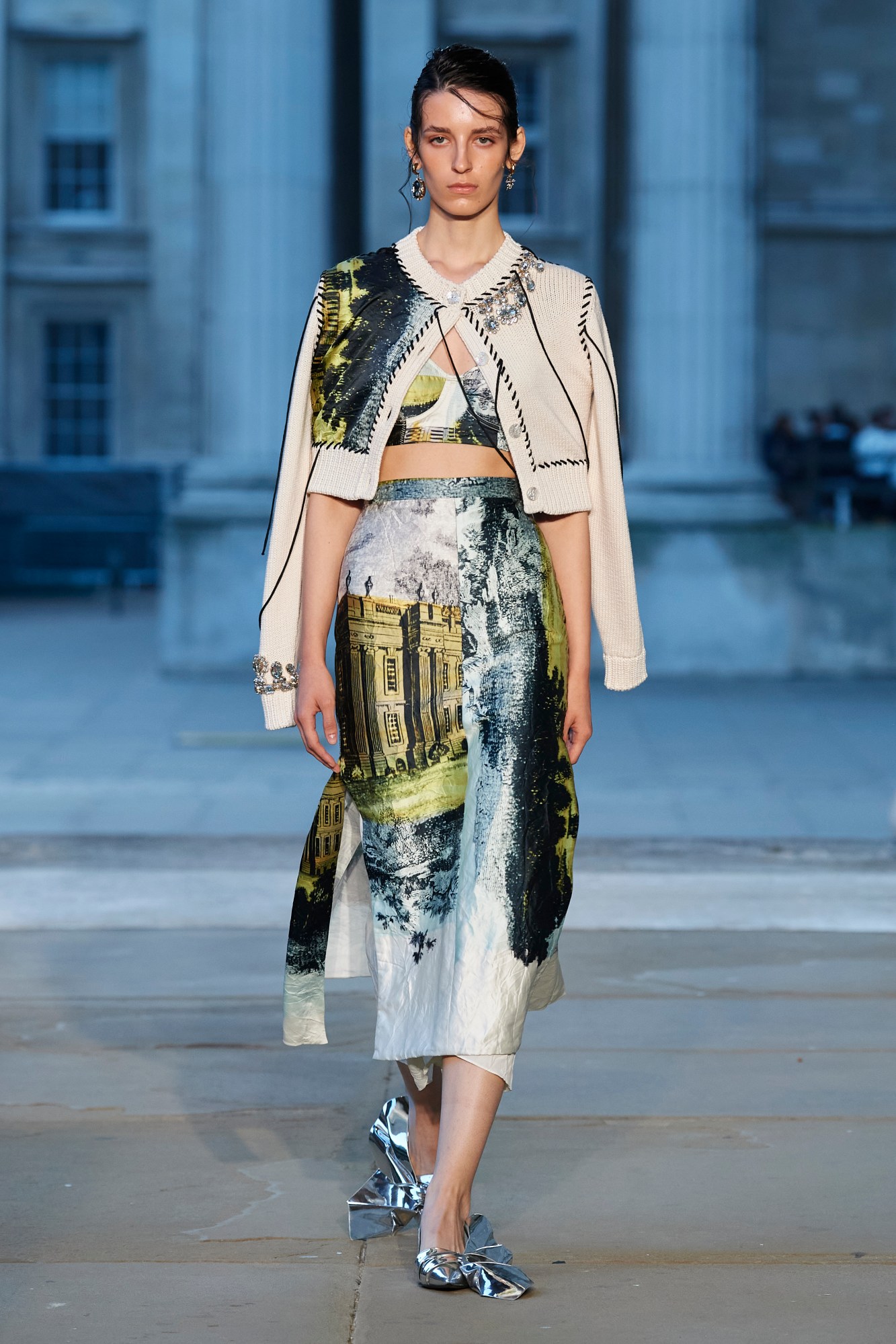
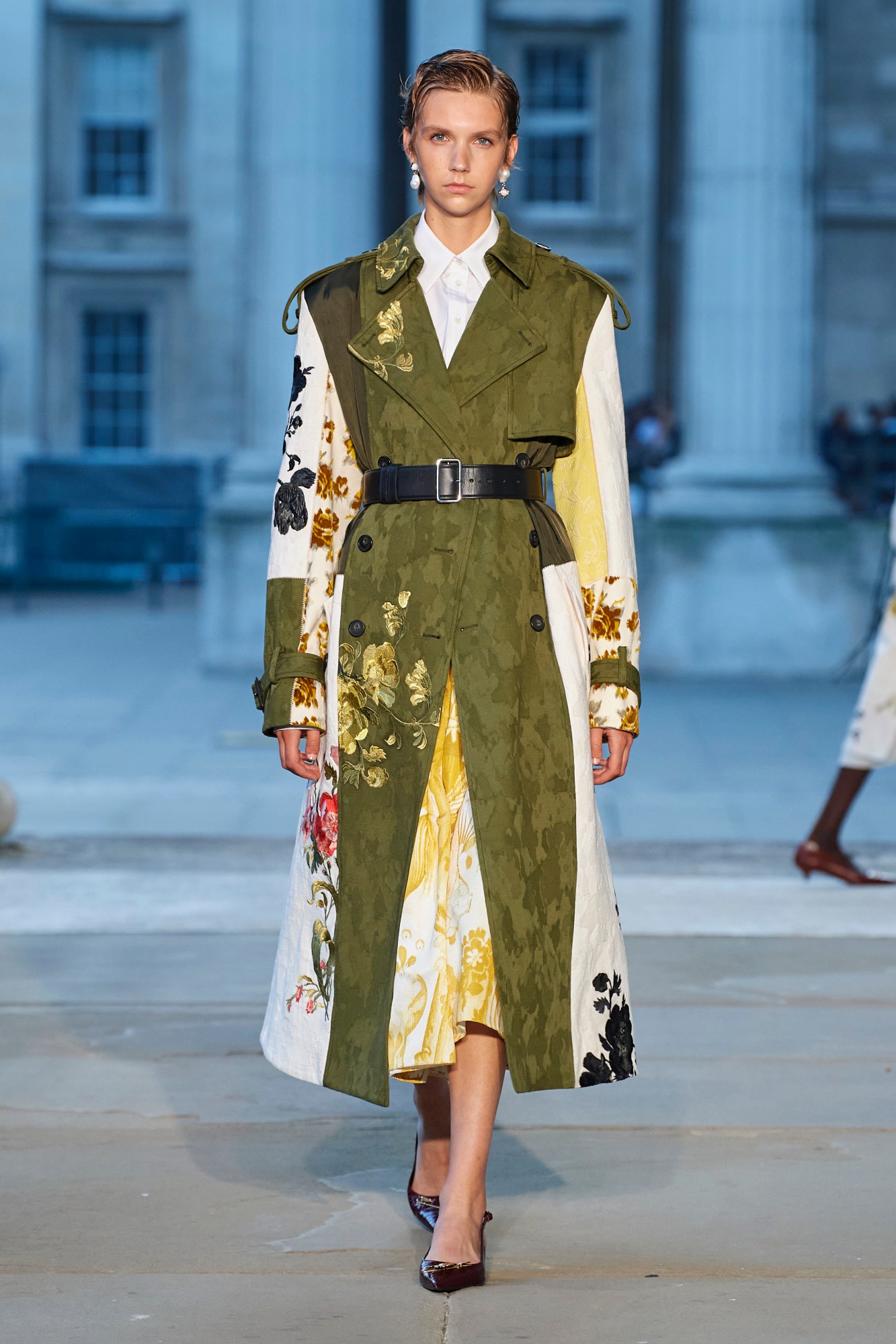
Erdem
Against the majestic backdrop of the terrace of The British Museum, the opening look of the Erdem show saw a model with an oversized sand-waxed barbour jacket, spliced with the kind of botanical quilted bed covers and curtains you’d find in a country house bed chambers, hanging low on her shoulders as if she slipped it on over a chemise for a late night stroll. On her feet were heels wrapped in silk, flaps of the fabric extending out far past her toes resembling the feet of a chicken.
Beautiful yet perhaps confusing out of context, this was a collection inspired by the late Deborah “Debo” Cavendish, the Duchess of Devonshire, aristocrat and socialite – as well as the last surviving member of the famed Mitford sisters – and the family estate Chatsworth House that she’s kept alive. Indeed, those quilted curtains fashioned into overcoats and pleated dresses had come from the actual furnishings of Chatsworth itself. Nods to Debo’s love of the outdoors come through in elbow-length leather gardening gloves that matched the belts cinching gowns with bushes of floral embroidery, dragonfly brooches and bug jewel embellishments. Chickens, a favourite animal of hers, were not only showcased in the shoes but in the meticulously detailed embroidered designs of coats and modest gowns, the threads then pulled away to resemble the feathers of the bird. The British aristocracy vibes continued with pastel slips featuring panels of doily like lace, tweed suits that became increasingly frazzled towards the bottom and evening gowns etched with a rubberised drawing of Chatsworth.
With each new look on the runway, we seemingly moved through the decades of Debo’s life; from the austere Britishness of the first half of the twentieth century, to the 50s, as bouncy, shoulderless gowns came in retro pops of neon colour and were matched by oversized biker jackets studded like they came out the Baz Luhrmann Elvis film – Debo was a fan of The King, after all. Structured bralettes were made modern by being worn as tops, with midriffs on show above skirts adorned by tapestries once held at the estate and now moved to galleries and museums. The collection ended with a series of deconstructed, semi-couture gowns, with calico tull and remnants of textiles found in the house each intricately hand embroidered – some by Debo’s own great granddaughter – and crystals and enamel stones threaded fluidly between. The Mitford Sisters, their estate, their riches and famed life stories have long been a source of inspiration for artists and designers for decades, but Erdem Moralioglu went deeper – helped by the archivists at Chatsworth – creating a retrospective that spoke to the final Mitford Sister on a personal, human level. TG


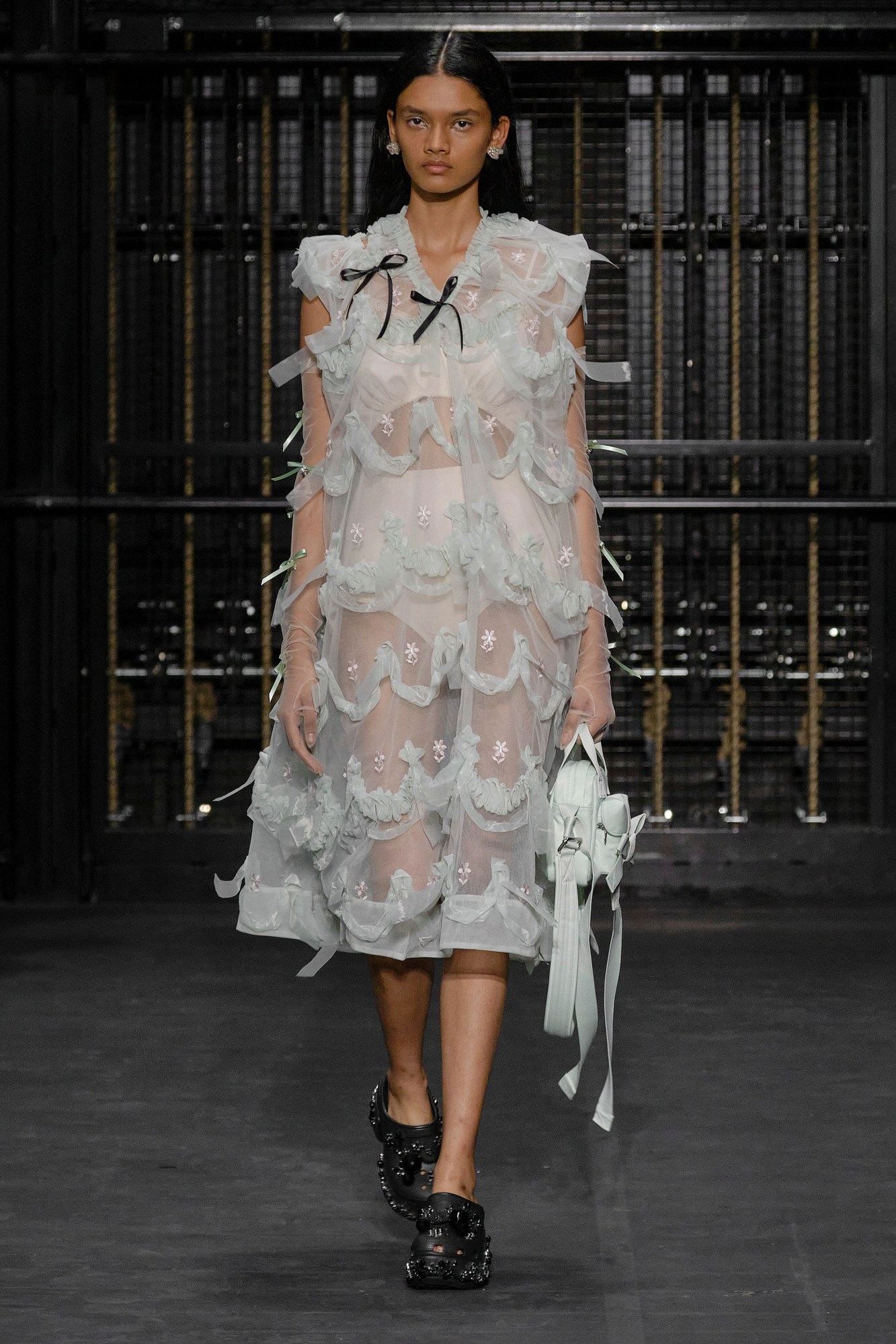
Simone Rocha
When Simone Rocha presented her SS24 collection at the new home of the English National Ballet, out in London’s docklands, it was not yet common knowledge that she was to be the next designer to be invited to create a couture collection for Jean Paul Gaultier. Looking back on it now, though, the body of work she presented on Sunday felt like a perfect testament to why the Parisian house looked her way, with the collection that filed around the blacked-out space a tender exercise in the poetic resonance and nuanced theatricality that one often associates with fashion’s highest art form.
A fawning romance, a longstanding trope of Simone’s work, made itself felt from the outset in the form of rose motifs that recurred across the line-up. At first, they appeared as clumped rosettes on pink, satin-finish cropped nylon windbreakers and pencil skirts (and later on papery poplin shift dresses and navel-baring abbreviated vests), but they bloomed into something more literal – actual roses held beneath ghostly scrims of tulle in nightshade black and dusty – you guessed it – rose, pinned to the internal constructions of macintosh coats, zip-fronted, nipped-in gowns and the puff sleeves of chore jackets.
As implied by the matrimonial tone of the show’s typically sparse accompanying notes – which, this season, comprised a list of cryptic look descriptions correlating to traditional wedding anniversary gifts – this love-y tone was compounded by double-strapped trapeze dresses in diaphanous gauze, tiered and ruffled empire silhouettes in wedding cake white, and delicate embroidered lace shirting. Anchored by a suite of pearl and crystal embroidered Crocs – hinting at a forthcoming collaboration – it all made for a collection that whetted appetites for whatever Simone will be serving up come January in Paris. MS
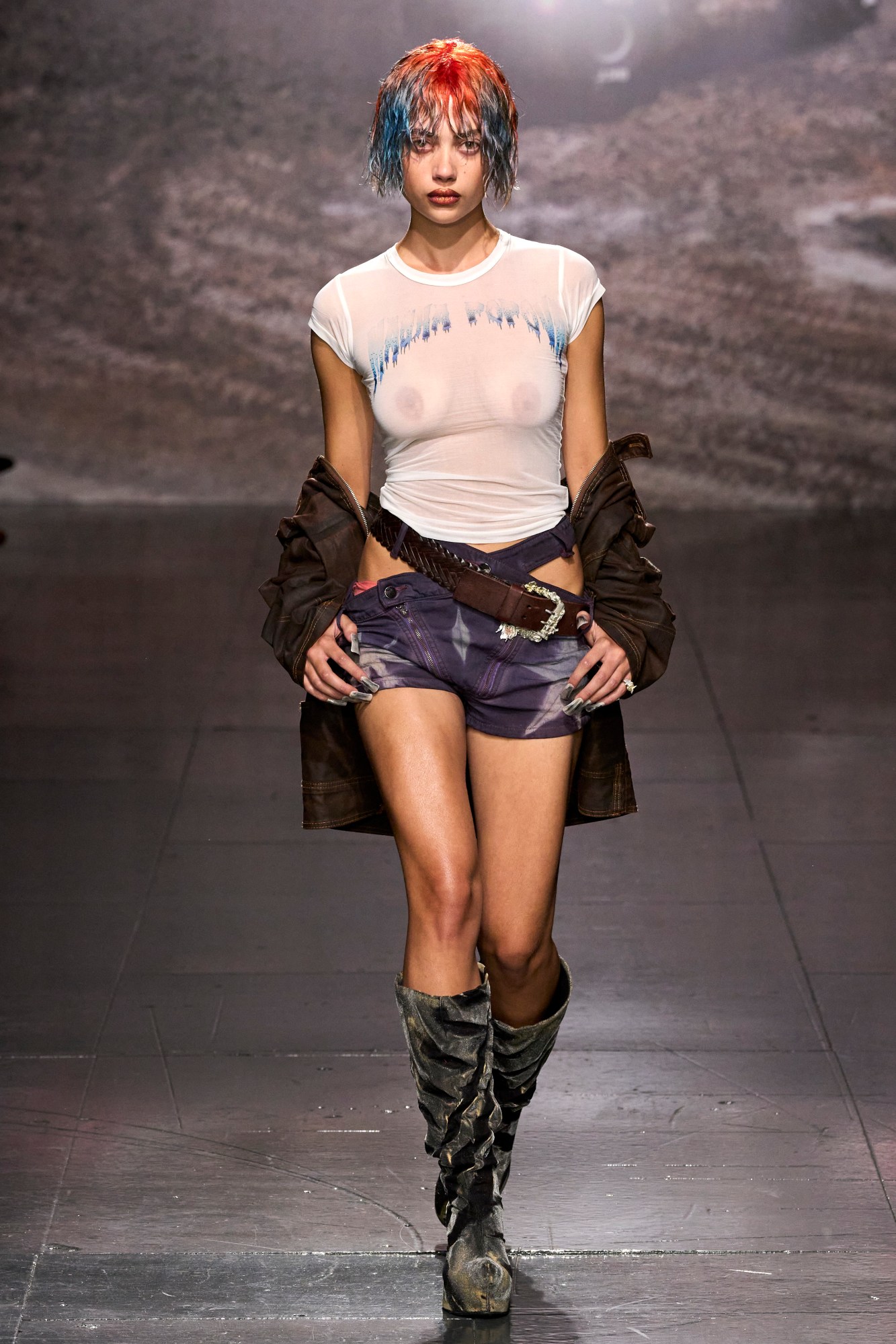
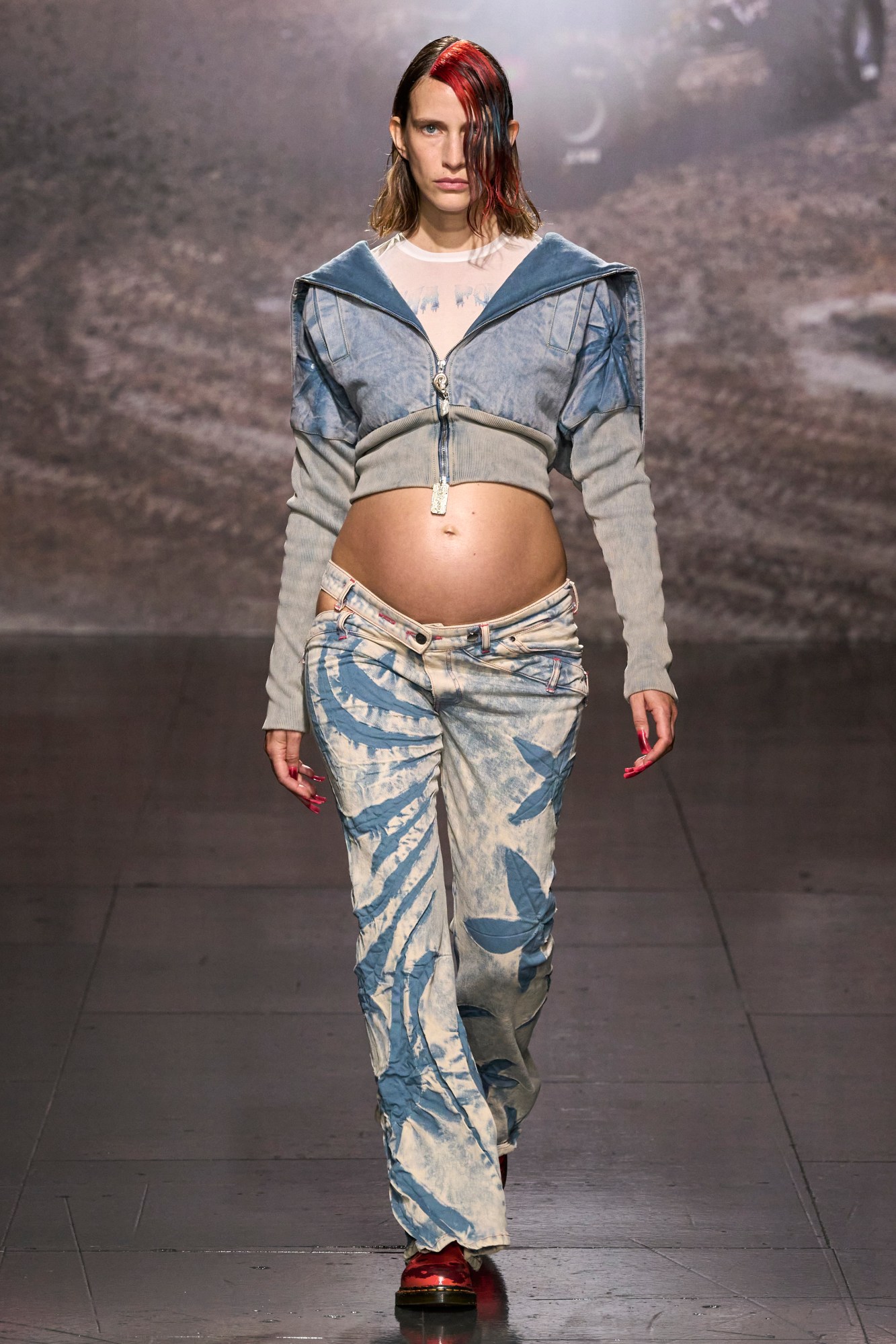
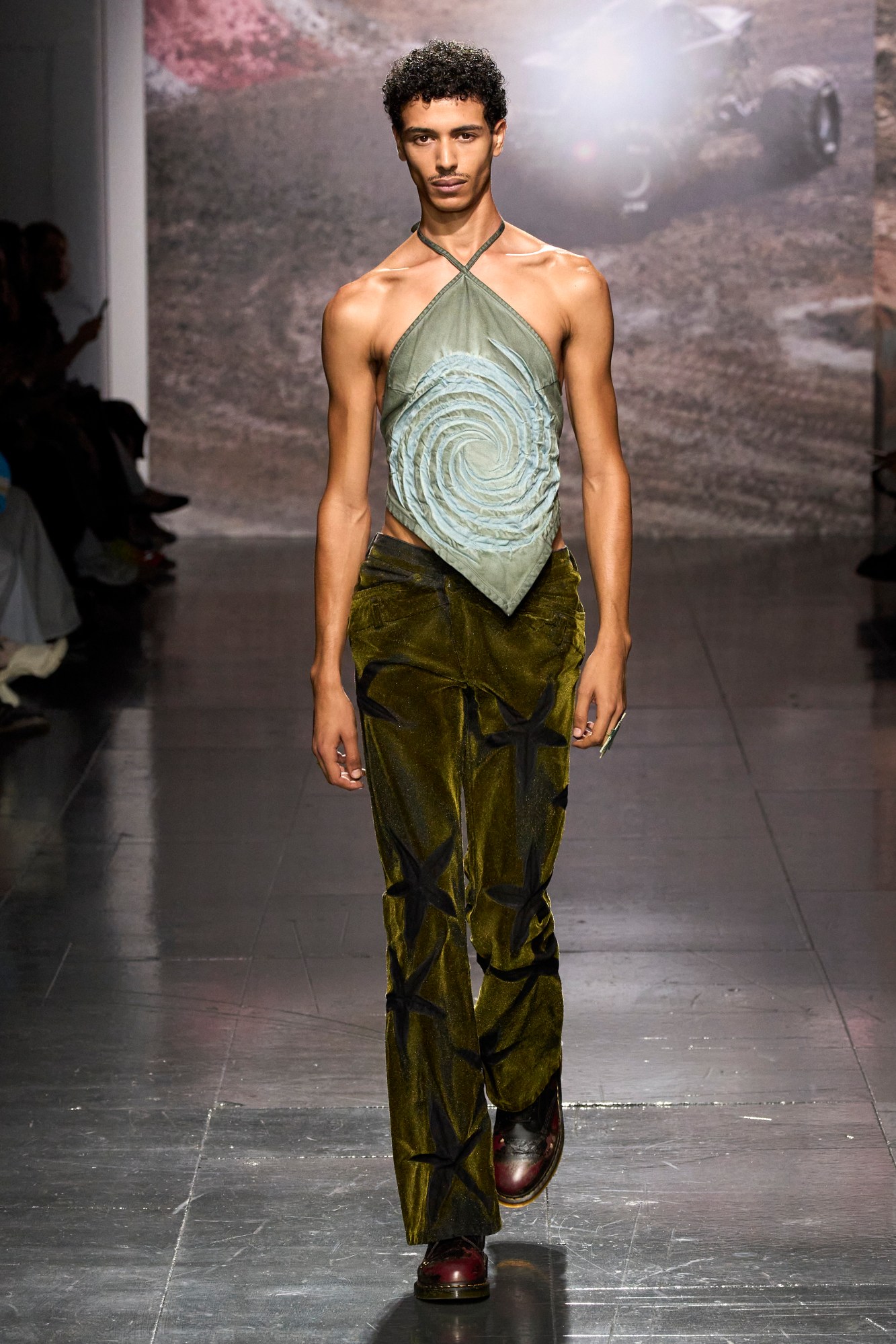
Masha Popova
Continuing with the adrenaline junkie energy of her last collection a year ago, Masha Popova’s AW23 and SS24 collection was an ode to the car obsessed girls with a 00s aesthetic. Think: Megan Fox bent over the hood of a car in Transformers. But here the motogirl wasn’t just satiating her car obsession, she was chasing the ultimate petrol head high: the monster truck.
Although, the garments adorning the models walking Masha’s show looked less like they had been at the wheel of the aggressively large vehicles and more like they had been underneath them. Tyre tracks rose along low-rise, high-slit maxi skirts and grew out of the stars on backless halter tops while the mud flying off the revved up tires splatters across trouser hems. Masha’s experimentational treatment of denim, saw pieces put through the ringer through intense dying, stratching, patchworking and fraying, and in electric tones that would be seen painted onto the trucks to add to their menace. Elsewhere velour mini dresses and hoodies and sheer white tees are dyed to appear like they’re rusting away and mini stars appear across many of the pieces, the shadows of sparks flying off a mechanics wheel. The motochic garms of the Masha girl aren’t just having intimate encounters with the gargantuan four-wheelers, they’re morphing into them – perhaps more Titane than Transformers. TG
Mains
Skepta, the modern-day renaissance man, is officially back on Planet Mode – not that he ever left. Reigniting his London label Mains after a brief hiatus, the appointed king of grime delivered his SS24 collection last night, toasting the brand’s comeback with a tennis-themed runway debut during London Fashion Week. Read our full review here. JB



Ashley Williams
Ashley Williams SS24 asked the prescient question, what are Gen Z, Olivia Rodrigo-loving, Sofia Coppola-coded teen girls wearing to the apocalypse? For her debut at the XLNC programme (Fashion East’s Lulu Kennedy’s talent incubator to take her former prodigy’s brands to even higher heights), Ashley’s show brought the post-civilisation 90s characters of Yellowjackets to the modern day, whilst also playing on pre-modernity motifs.
As a vocally-distorted version of Britney Spears’ sweet sad girl classic “Everytime” played, models walked around a space suggestive of the Colosseum or an illegal underground fighting ring. They held spears, axes and creepy, anonymising face masks that matched their cutesy, frilly gowns and nodded to similar ones worn by coy women in the 16th century. This cannibalistic cult of girlies stormed the wasteland in worn down ballet flats, odd and shredded knee-high socks and all the consumeristic fast fashion they looted from abandoned Hello Kitty shops and the accessories section of department stores. Baby knitwear was fashioned into protective wool hats, the arms flopping down in a way reminiscent of a medieval jester, and the styles of garments today – bandeau tops, low-rise mini skirts and motorbike jackets – were fashioned from mushroom leather. They may be in survival mode but that doesn’t mean self-expression has to go out the window after all. That was additionally expressed in white smocks adorned with messy punk scribbles like they’ve been attacked by feral children armed with crayons, and graphic tees and patchwork print hoodies that featured religious iconography, unborn babies and preachy sentiments that spoke to the political and social issues that have been a dividing force online, as tweets in a post-internet world were moved to tees. Underpinned by the “I heart ME” leisurewear and UGGs, who supported Ashley’s comeback too, this was an exploration of what stays (either because of desire, or because consumerism has created so much of it) and what goes in a post-civilisation world, and the result was a very wearable collection that is bound to bring about armageddon on its release. TG
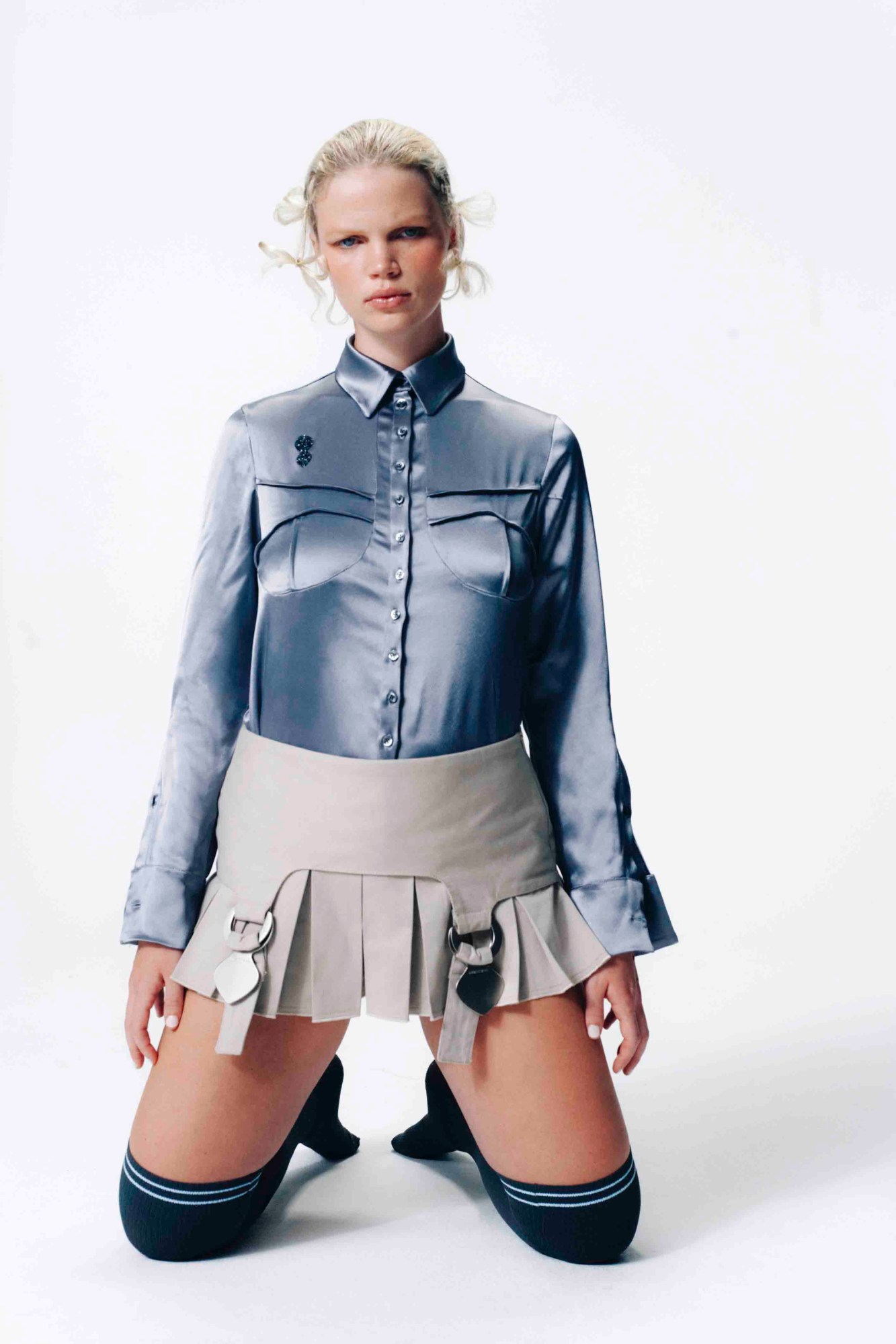
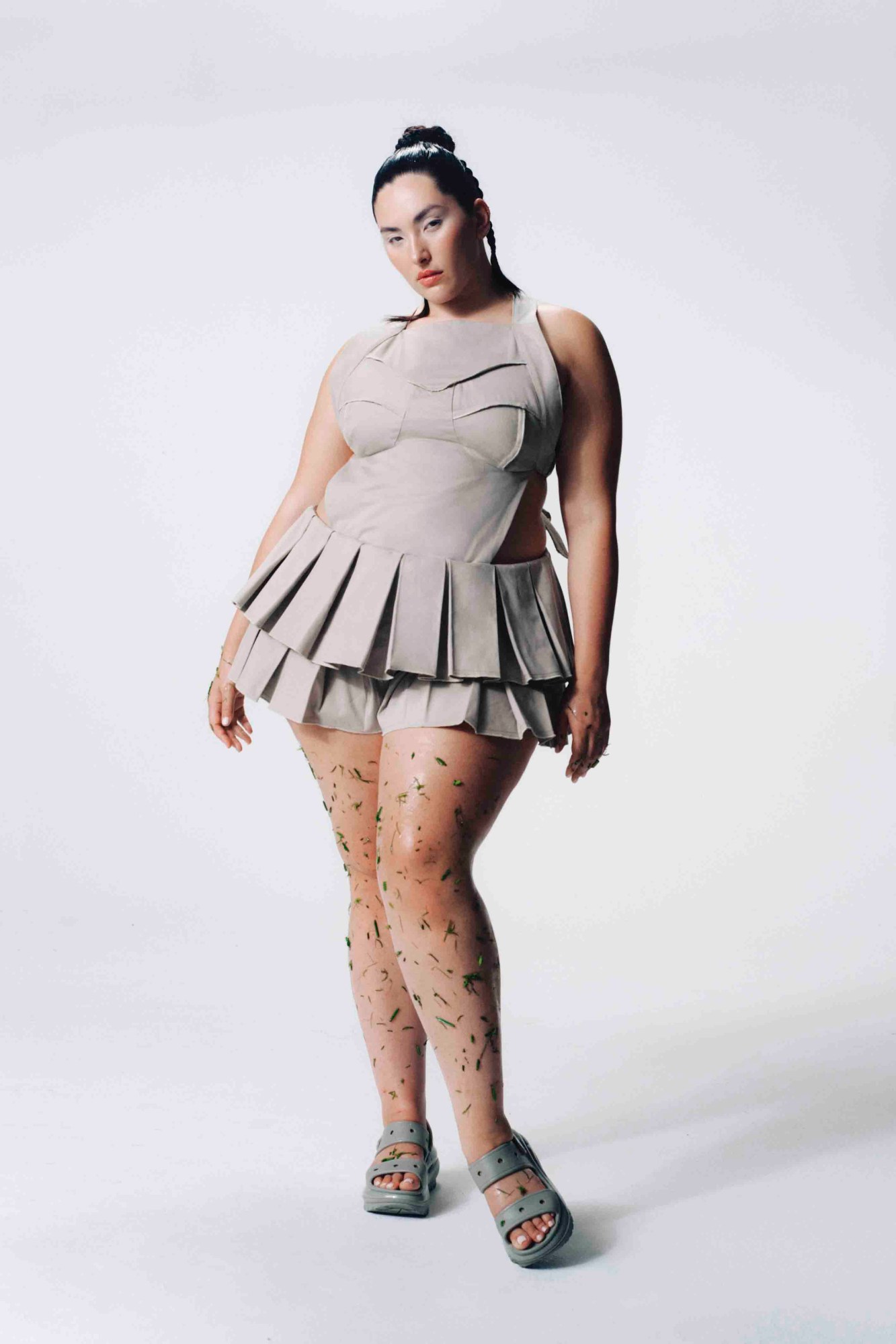
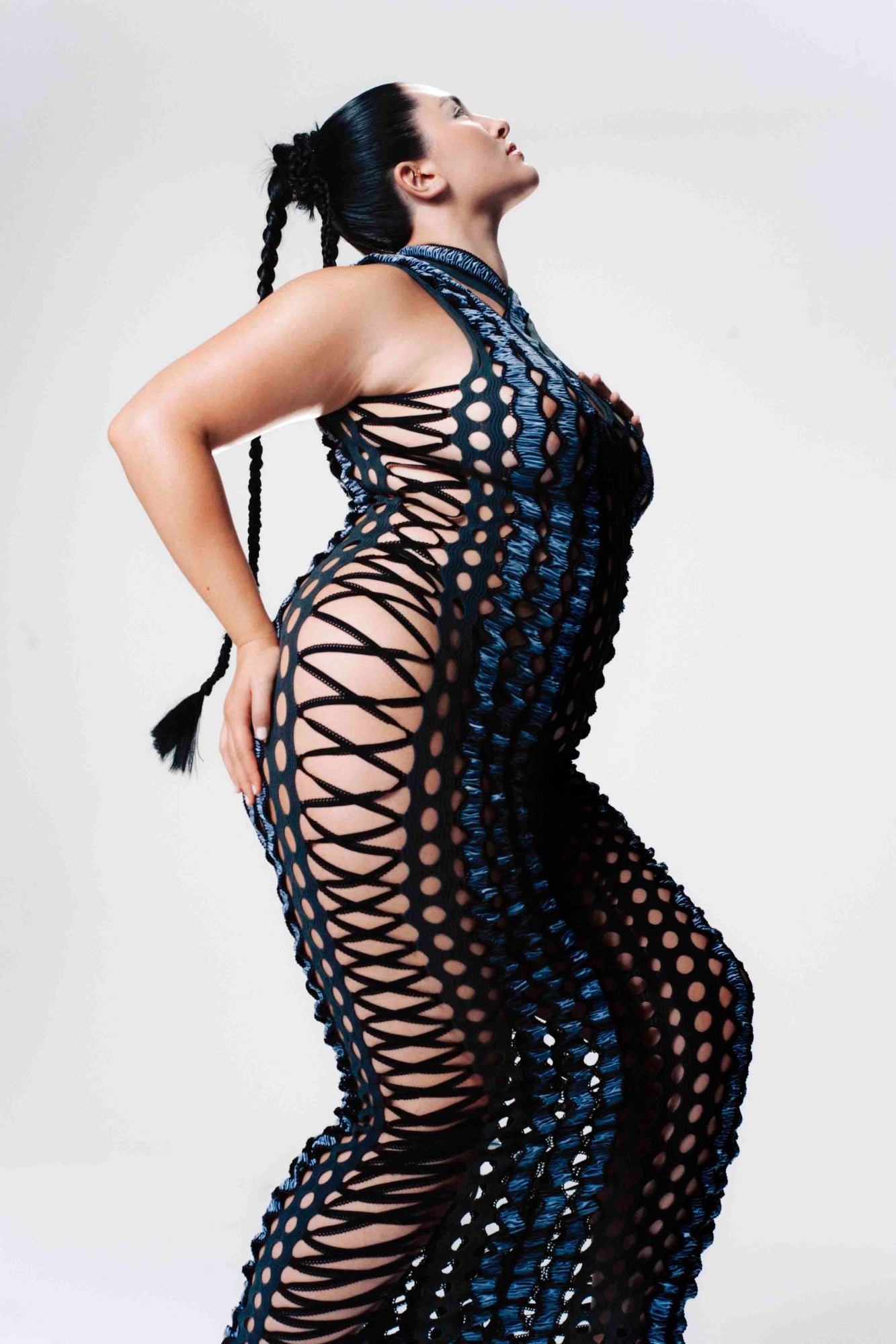
Sinead O’Dwyer
Although the traditional fashion week schedule model is an exciting and impressive spectacle, it’s a gruelling one too. The breakneck speed of the calendar, the pressure to create entire collections – in oppressively prescriptive sample sizing – and then to display that work in 20 minutes or less before everyone dashes off to the next thing, armed with only their phone cameras… well that’s all something that Sinead O’Dwyer decided not to bother with this season. Instead of relegating an explanation of her SS24 collection to show-notes and Instagram captions, the designer slowed things down completely, eschewing a traditional runway show for an assembly-like Q&A with i-D’s own Mahoro Seward.
To do so, Sinead took London’s fashion set back to where it all began for her eponymous label: the corridors of RCA, where as a student the designer began questioning much of the established ‘rules’ of fashion creation, notably, the expectation to work from one cast or ‘block’, which has traditionally meant that clothes aren’t created with a real woman’s body in mind, or at least, only with one specific type of woman’s body in mind. “When you begin to study fashion you’re already being given the body that you’re going to be designing upon,” Sinead explained. “The mannequins are a certain size”
As the pair’s candid discussion of production and creation unfolded, models walked through the assembly space, allowing us to see and understand the clothes at the same time. The pieces themselves lifted inspiration not just from Sinead’s uni days but her teenage years at Killina Secondary School in Ireland’s County Offaly; think mohair pullovers, skyblue shirting, box pleated school-issue wool plaid culottes and the kind of rara shorts that would have definitely got you in trouble for your uniform (the thigh high striped socks couldn’t have gone over well at Catholic school either).
But all of these classic pieces are intuitively remodelled for ease of wear and the dynamic range of movement; there are swathes of elasticated knit, shirred satin bands, complex body harnesses decorated with Swarovski beading. The windowpane detail that Sinead introduced in SS23 has reappeared here, as well as the butt plug motif that first debuted in AW21. But it’s not just audience favourites this season; the designer has also made her first foray into denim jeans, featuring the brand’s new insignia (in Swarovski crystal applique, of course). “The first decision you make should be the body that you design for”, Sinead told her captivated school assembly yesterday afternoon. The result of that decision is a collection centred on the body in all its iterations; on movement, rather than mannequins. RL



16 Arlington
Fashion is weird, of course, but it’s not often specifically Lynchian-subtype weird. 16Alington’s SS24 show, was notable in being Lynchian weird. Specifically, it was inspired by Lost Highway, David Lynch’s 1997 trippy neo-noir surrealist psychological horror, which is as much a murder mystery as it is an exploration of coincidence, doubling and dopplegangers. The show space, too, was set up to be reminiscent of a winding highway. Models weaved and floated their way through a snakes-and-ladders type set up, which was meant to evoke not Lynch’s Californian desert but instead London’s busy nightlife. “It’s the freedom that comes with getting behind the wheel and just driving,” the show notes told us., “That sense of potential, of escape. That you can go anywhere, be anyone.”
A sense of dream like doubling and creating a new self permeated the collection, which was both sleek and simple, both understated and elevated – tailored wool coats, long silk dresses, courts and kitten heels – and filled with allusions to illusion – huge sequins on bags and embroidered onto skirts, trompe l’oeil style mega bags, fuzzy knitwear layered over glitz. The effect is luxury but a new type of luxury, a woman or man who would be as at home falling out an uber into the club after languishing in central London traffic as they would in the boardroom, a few errant mega-sequins still stuck to their coat tails from last night. Imagine, if you will, Shiv Roy in the queue for Berghain.
“There is no such thing as a bad coincidence”, one of David Lynch’s characters says in the bizarre Lost Highway. The quote is resurrected for Marco Capaldo’s guests, reminding us of the illusory power of fashion to help us reimagine a new us whenever we want. To be both quiet luxury and feral rat party girl. Women contain multitudes. People are always saying this! RL
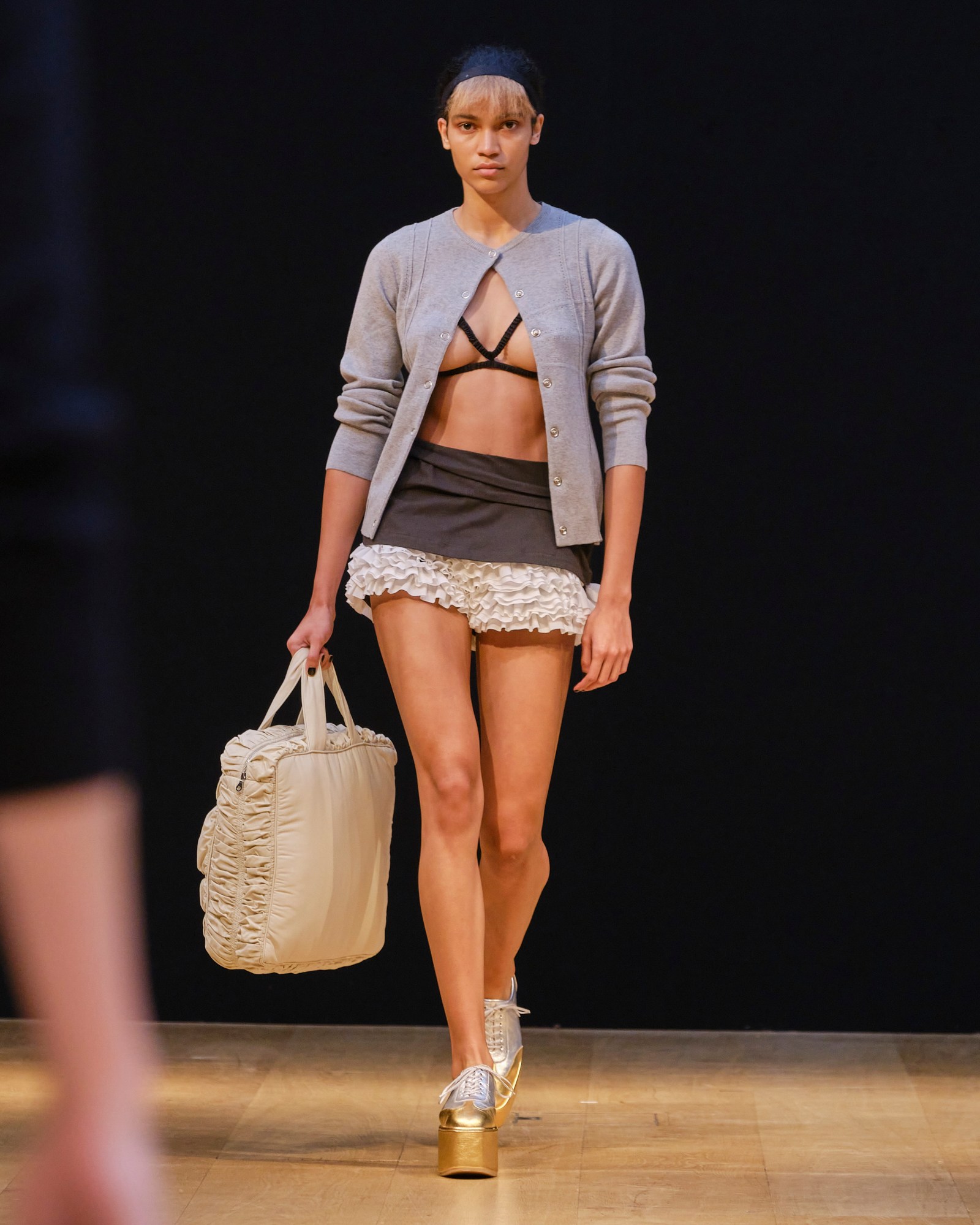
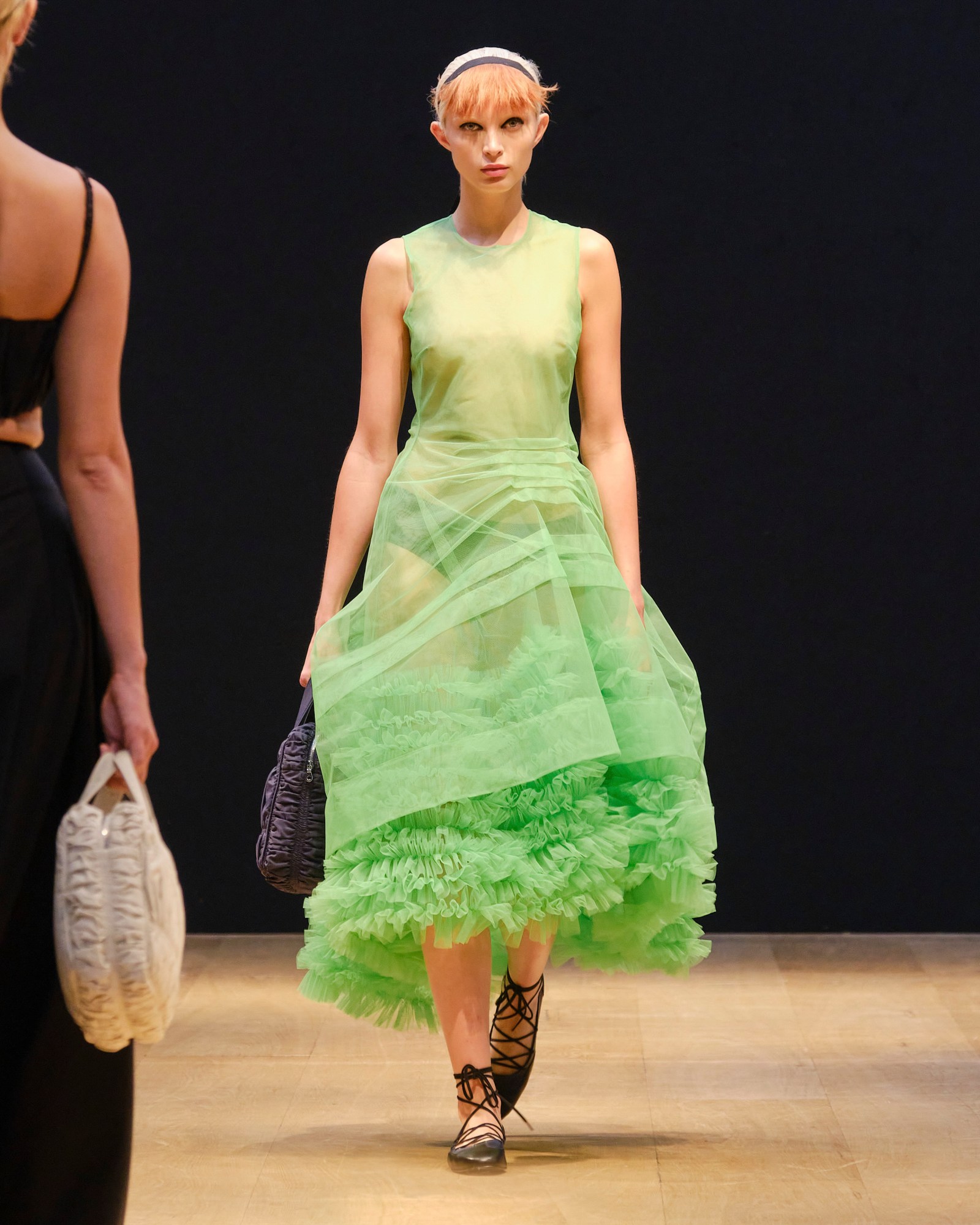

Molly Goddard
For her SS24 collection, Molly Goddard took to the salerooms at esteemed auction house Christie’s to present a body of work that offered a tender, slightly twisted exploration of the inner workings of clothes – the strapping, boning, binding and all. Beginning her research at the National Theatre costume hire department, the designer’s eye was drawn to pieces that typically play a supporting role – often literally – in an outfit’s construction, like crinolines, Georgian underskirts and 1950s bras.
Her study of these pieces led her to consider ways to bring these typically concealed features to the fore, often through subtly twisted-and-screwed moments of revelation. For the show’s opening look, for example, a black wool cardigan peeked open to reveal the ghostly outline of shirred bra, while a taupe canvas skirt was hitched up, with the ruffles of a white cotton underskirt spilling from the hem. A similar skirt story unfolded across a grey canvas number, black miniskirts and A-line midi-dresses, while fringes of tulle peeked out from beneath smock dresses in cotton the texture of curtain lining cloth. Tulle, naturally for Molly, featured prominently, though this seasons polychrome confections has a distinctly spectral timbre to them, with visible bindings revealing the interior architectures of tiered dresses, and with bulky gathers of the fabric sprouting from the hips of drill trousers like panniers. All in all, it’s a collection we’d happily put in a high bid for, given the setting it was shown in. MS
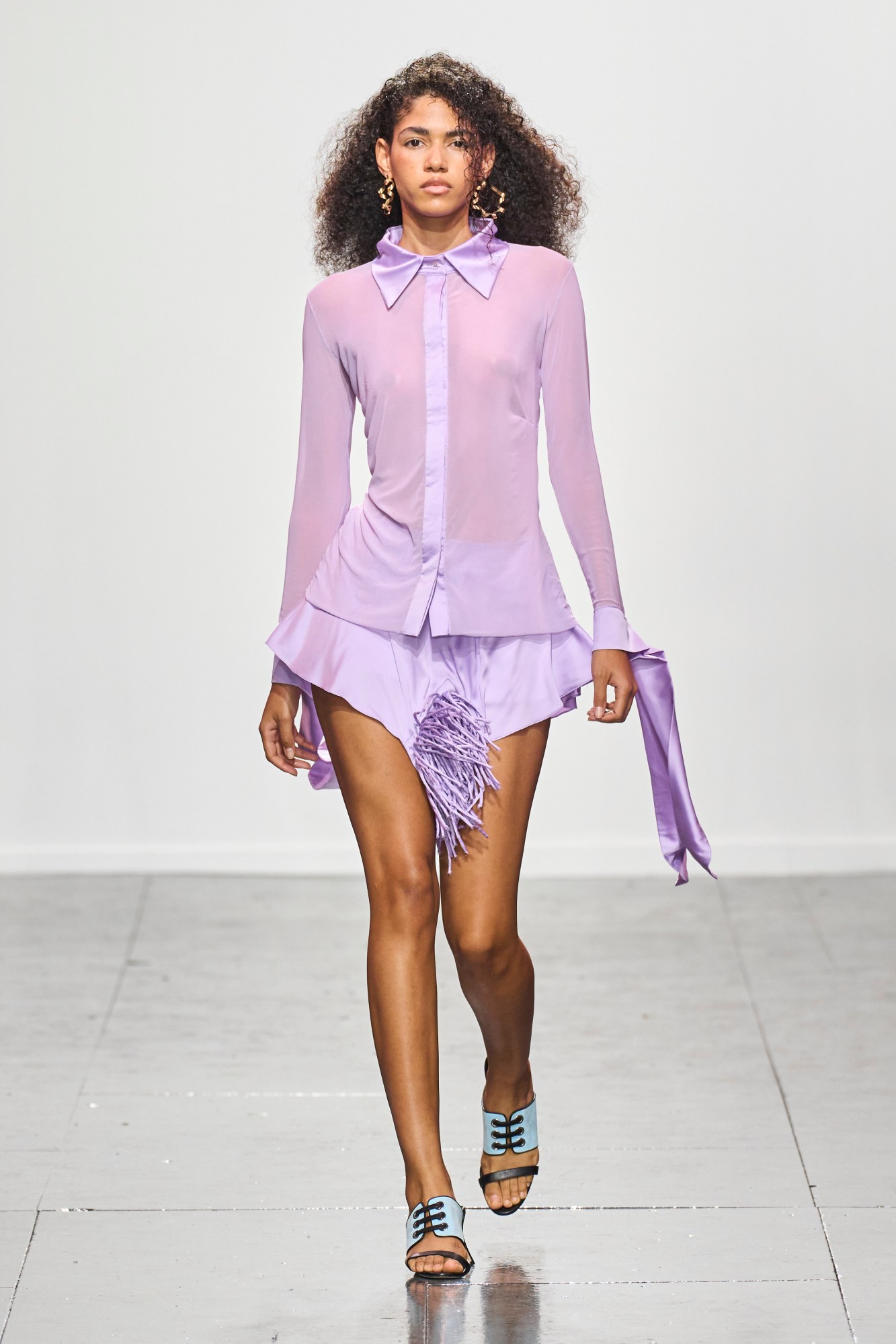
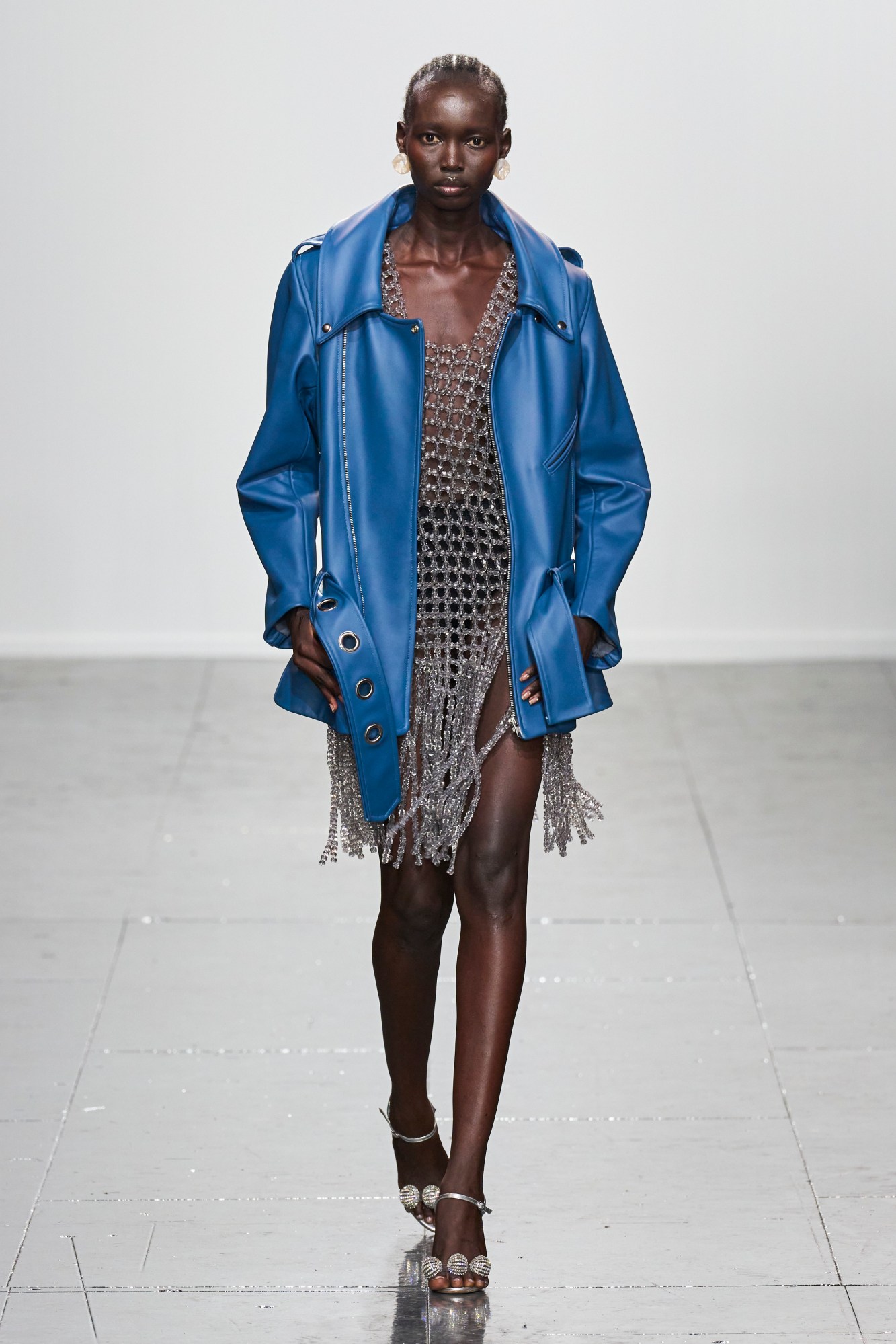
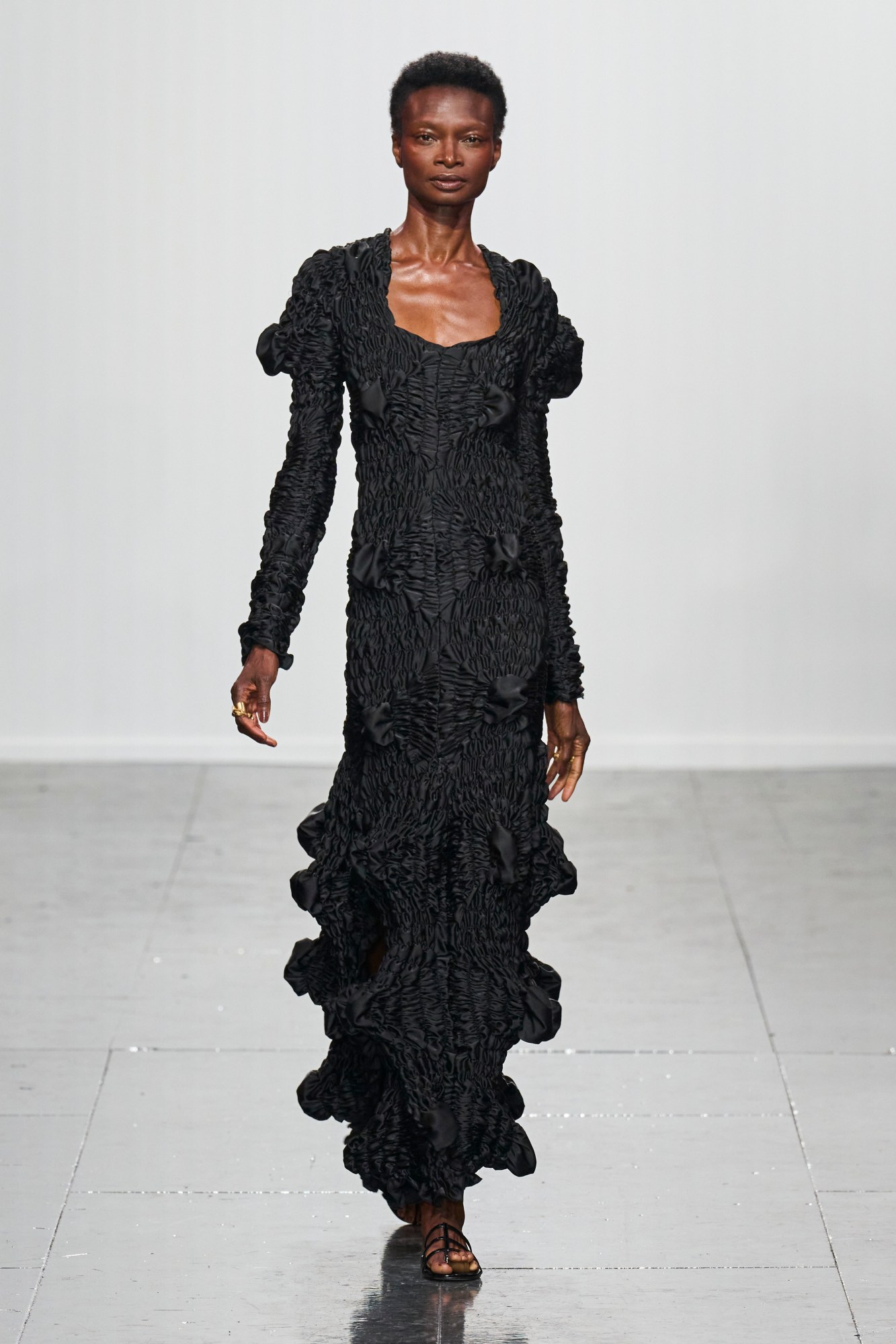
Feben
“My body is a temple,” is the kind of thing you’d hear the fash pack say as if they haven’t spent the entire week living off cigarettes and free Diet Cokes given out at the shows. But Feben SS24 looked at the mantra from a different, more spiritual and locational, as well as physical approach: where does she want her own body to be seen? How does she want it to be seen, remembered and iconographed? To search for the answer to this, she looked to artist Carrie Mae Weems and the beloved, late Sinead O’Connor, a key figure of inspiration and dedication this season.
The label’s iconic twist dresses were given an update with puffed sleeves and stiff square necklines that contrasted the chaos and movement of everything below it, and came in tones of black – as seen on the original Alexander McQueen muse Debra Shaw, redolent of Carrie Mae Weems’ “Museum Series” – and in marble, like a Roman temple. The body was celebrated too, whether that be Feben’s own – abstractedly printed onto white trompe l’oeil naked dresses and tops, her mark literally left on the garments she makes – or the models bodies, as they strutted in shimmering glass bead-fringed chainmail and silky garments that look like they were one snapped strap away from falling off. The spiritual freedom of the liberated, uncontrolled body was best epitomised by maxi dresses spliced with a spiralling ribbon of sheer fabric down the front that both physically exposed the body below, and was reminiscent of the tail of a kite, free falling through the air. TG
JW Anderson
Between Loewe and his independent, namesake label, Jonathan Anderson has garnered a reputation as perhaps the most irreverent, willfully playful designer in fashion. Yesterday, at North London’s iconic Roundhouse, that was firmly vindicated with the opening look at JW Anderson’s SS24 show – a moulded grey hoodie and a pair of white shoulders, both rendered in a moulded, pinched-and-puckered material. Initial surmisals as to whether it was moulded leather or, perhaps, some ingeniously developed kind of pliable papier-mâché were swiftly dashed post-show, when Jonathan revealed that they were, in fact, moulded from plasticine. Read our full review here. MS
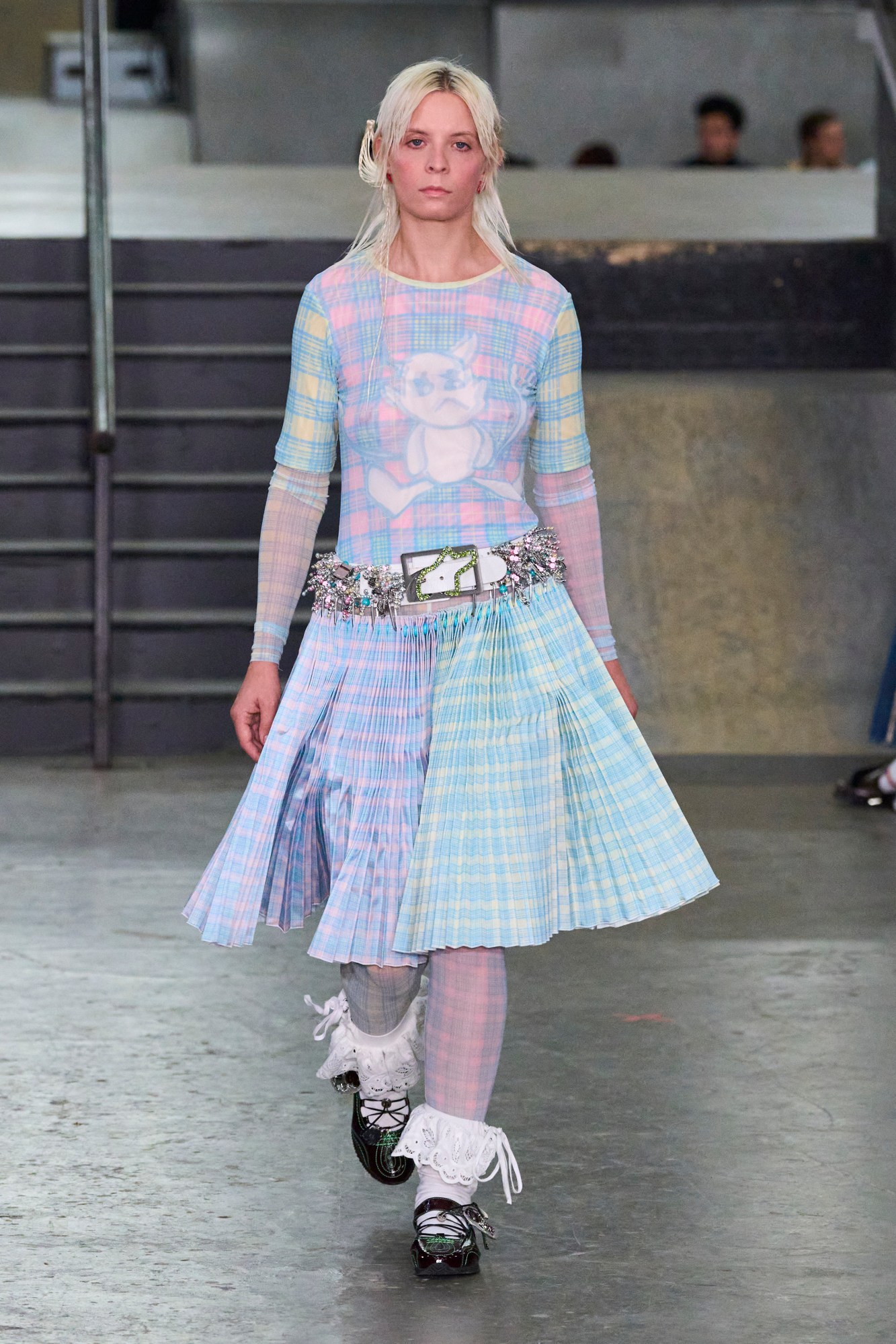
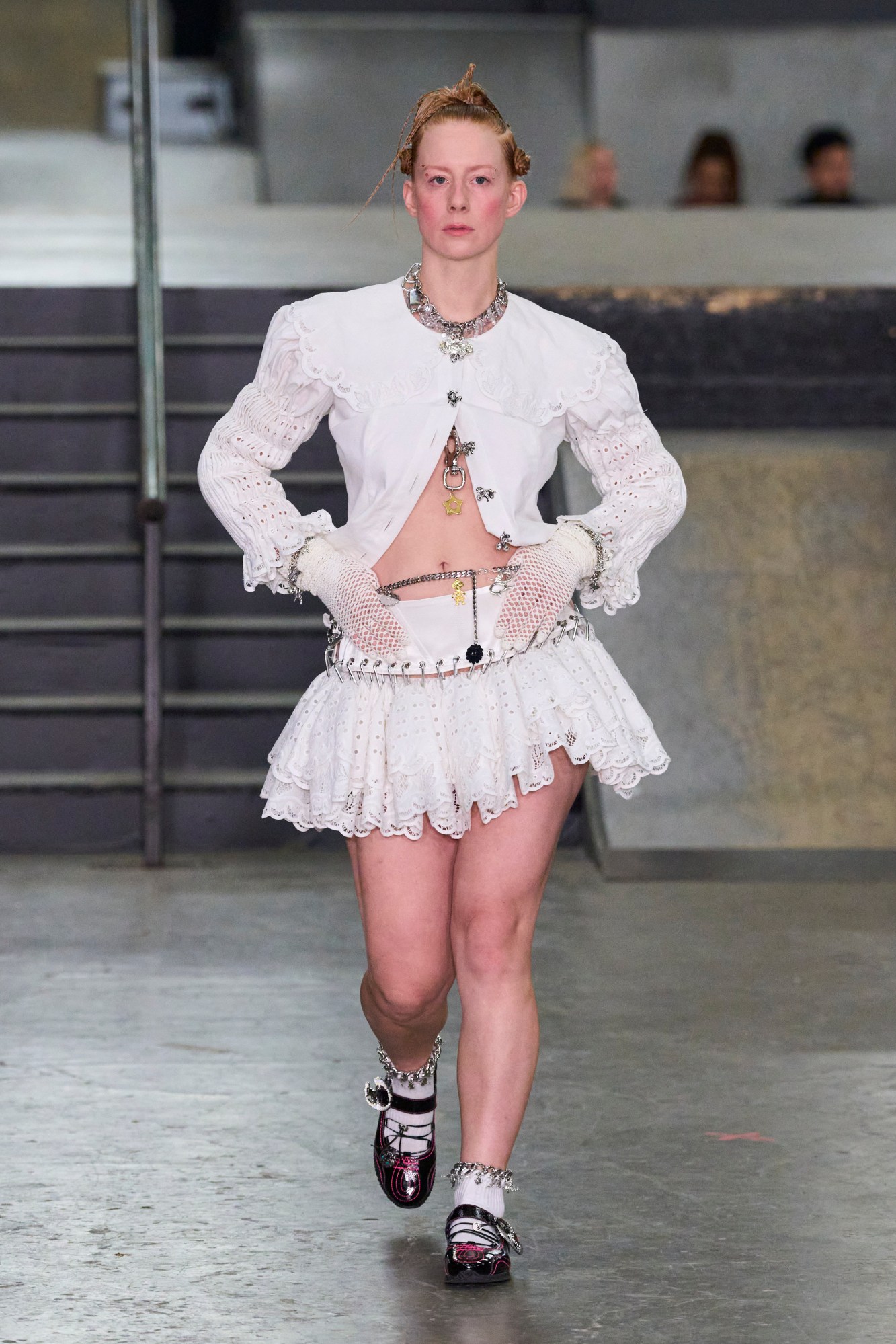
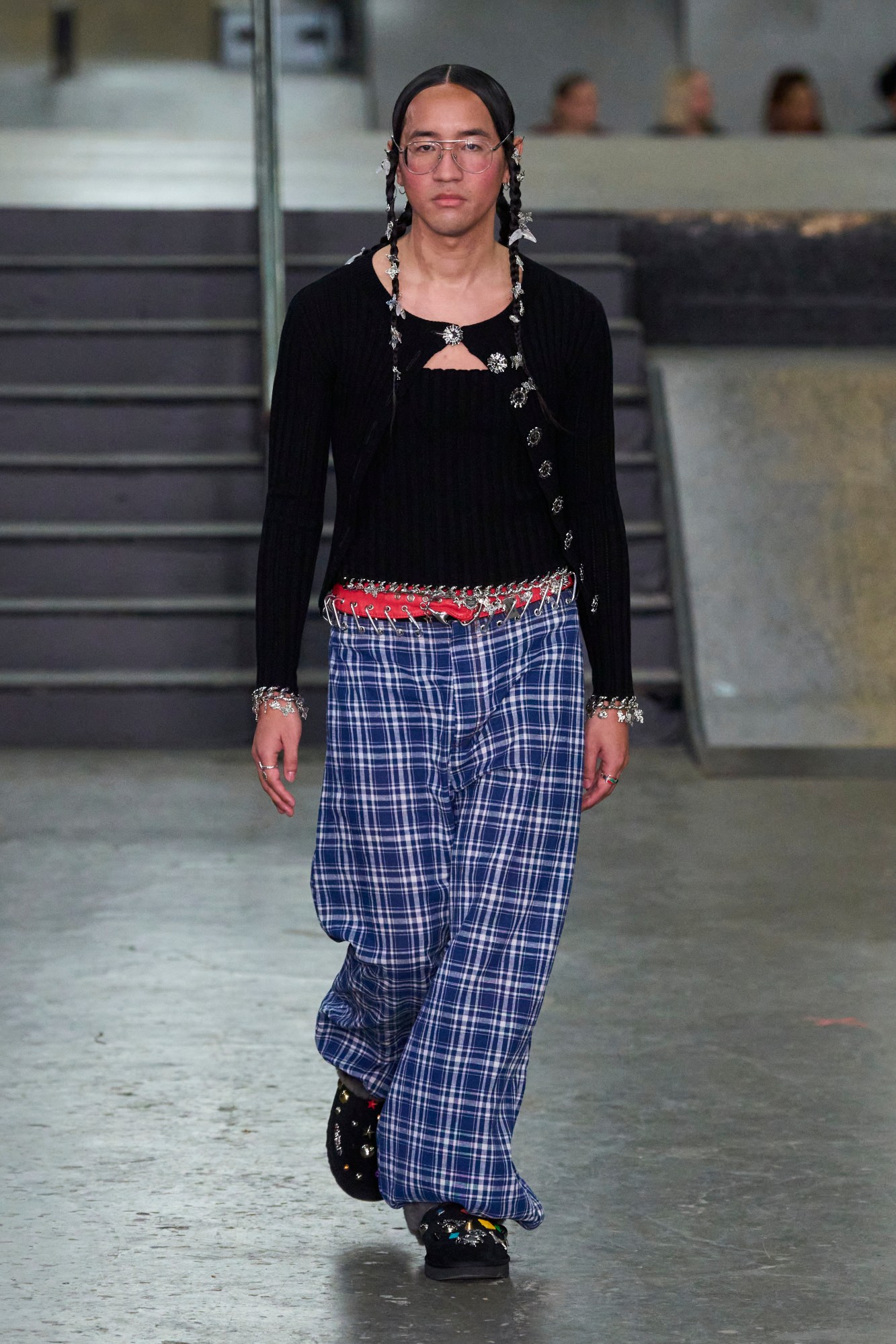
Chopova Lowena
There are few better indications of a brand’s cult appeal than turning up to a show to see (more or less) an entire audience clad head-to-toe in its wares. Pulling up to a sprawling West London skate park where, much like for its last – and first-ever – physical show staged last September, a motley crew of Chopova Lowena acolytes thronged concrete ramps and staircases in the brand’s unmistakable pleated, polychrome carabiner skirts, smocked and clocked gigot sleeved frocks and pre-school-drawing printed mesh tees.
At most fashion shows, such a sight would suggest a savvy attempt on the part of amazing brand PRs to cultivate an artificial sense of community – here, though, that was an organic consequence; essentially, the self bought (rather than borrowed) tapestry kilts and lurid printed fleeces that people rocked up in were marks of unabashed standom, like an (admittedly more expensive) echo of sports jersey or band tee culture.
Last night, the devotion of Chopova Lowena’s hoard worshippers – though perhaps not their wallets – was rewarded by what was easily the brand’s most accomplished collections to date. A dual exploration of the rituals that underpin Cornwall’s Flora Day festival – a traditional celebration of summer’s arrival, replete with processional dances, celestial garb and lily-of-the-valley motifs – and the sartorial vernacular of skateboarding, corseted dresses with leather straps and borderie anglaise bubble skirts, and flocked gowns with sporty mesh bustier panels figured in angelic white, simultaneously nodding to light, summery fare of the medieval-rooted procession as well as an Avril Lavigne-y air of grunge.
That energy was amply channelled by a suite of moodier, nightshade noir midi dresses, crop tops, and bombers with and without lace-trimmed, overblown Victorian collars, many of which came jangling with charm-laden chains that served as a key fil rouge connecting the collections dualistic themes.
Speaking of Avril, though, Emma Chopova and Laura Lowena-Irons’ interest in skate culture this season had less to do with the sport itself, and more to do with the sk8r bois that it feels like all of us fashion girlies have, at some point, been head-over-heels obsessed with. Their energy permeated this season’s menswear offering, the brand’s most robust yet, with baggy plaid pants and lace-hemmed jeans layered under tiered carabiner kilts and cargo skirts and board shorts, with printed baby tees, hoodies and bulky leather jackets up top. Perhaps the most notable expansion of the Chopova Lowena world, though, came by way of the arrival of long-awaited leather accessories, with a sporty climbing shoe-cum-mary janes accompanied by a godsend of a bag designed with slots for everything from custom notebooks and pens to nail files and combs, with ample space to spare, not to mention a skate-friendly mary jane and customised UGGs.
That this was a collection that will resonate with Chopova Lowena’s community was well-attested to by the thunderous applause that rang out when Emma and Laura took their final bow, following a procession of street-cast models that included close friends and family of the brand – with designer Sinéad O’Dwyer, photographer Ottilie Landmark and SSENSE buyer Nick Tran among the stellar. For proof, though, just wait a year, when you’ll see everything here on the runway lining the rows of their next show. MS
Mowalola
London’s anti-heroine, Mowalola does what she wants, when she wants. Last night, for example, she dragged it-kids and fash packers out in droves to deepest, darkest East London, ditching the official London Fashion Week schedule once again for something a little more her. Unhinged chaos, that is.
Her starting point? “I watched this really fucked up movie, Crash (1996), and that just set the tone for how wild I could go because the movie is about fetishising car crashes.” Notwithstanding the orthopaedic footwear lifted straight from the film, Mowalola treated this less as a direct reference than a carte blanche for smut and offbeat designs. Football polos were emblazoned with hentai, leather skirts no wider than belts clung to buttocks like McQueen bumsters, and elastic harnesses read ‘Mowalola’ – a must for style-savvy circuit queens. Elsewhere bras were belted across the back, while the familiar wet-look halterneck gowns showed face in black and red patina. Read our full Mowalola review here. JB

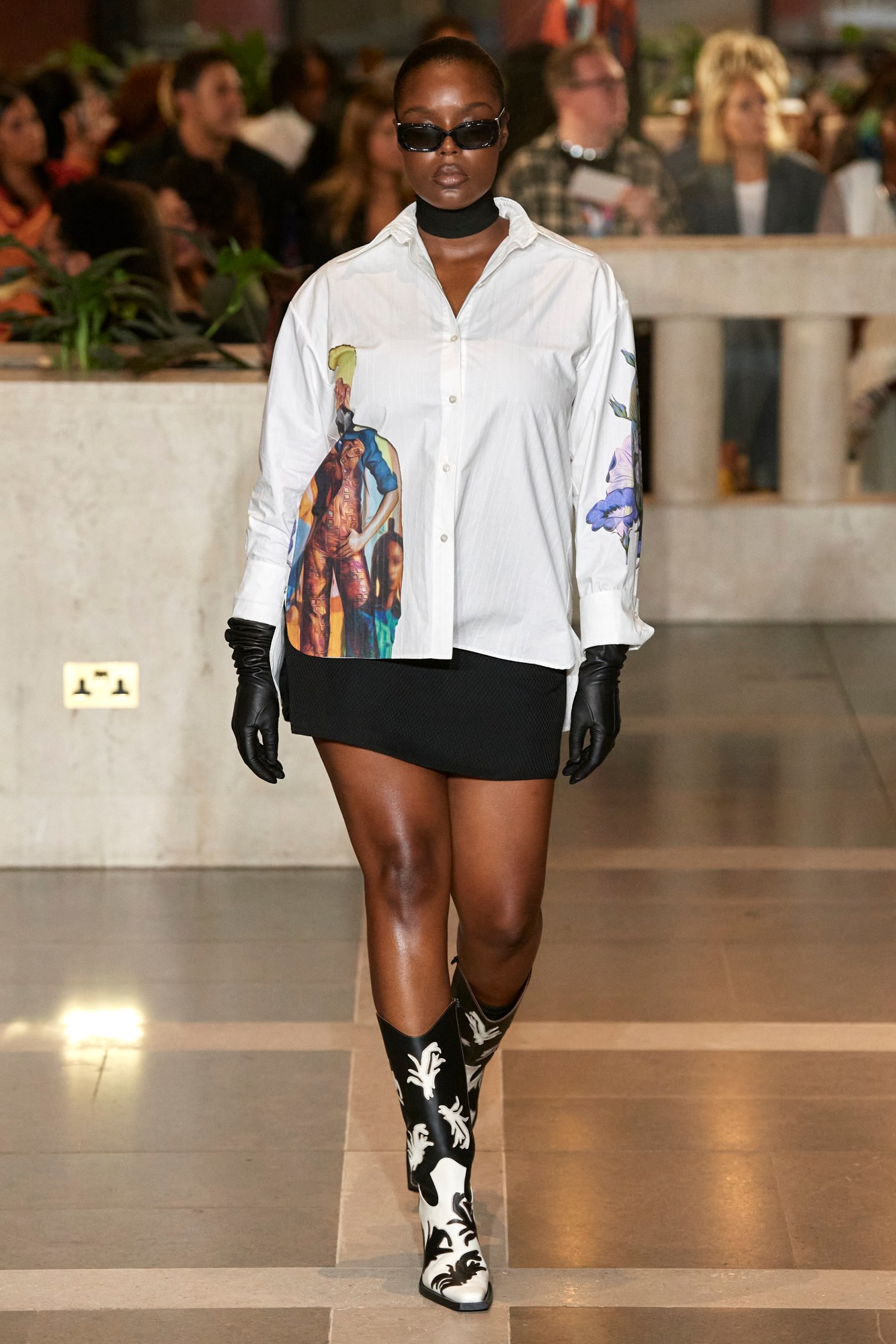
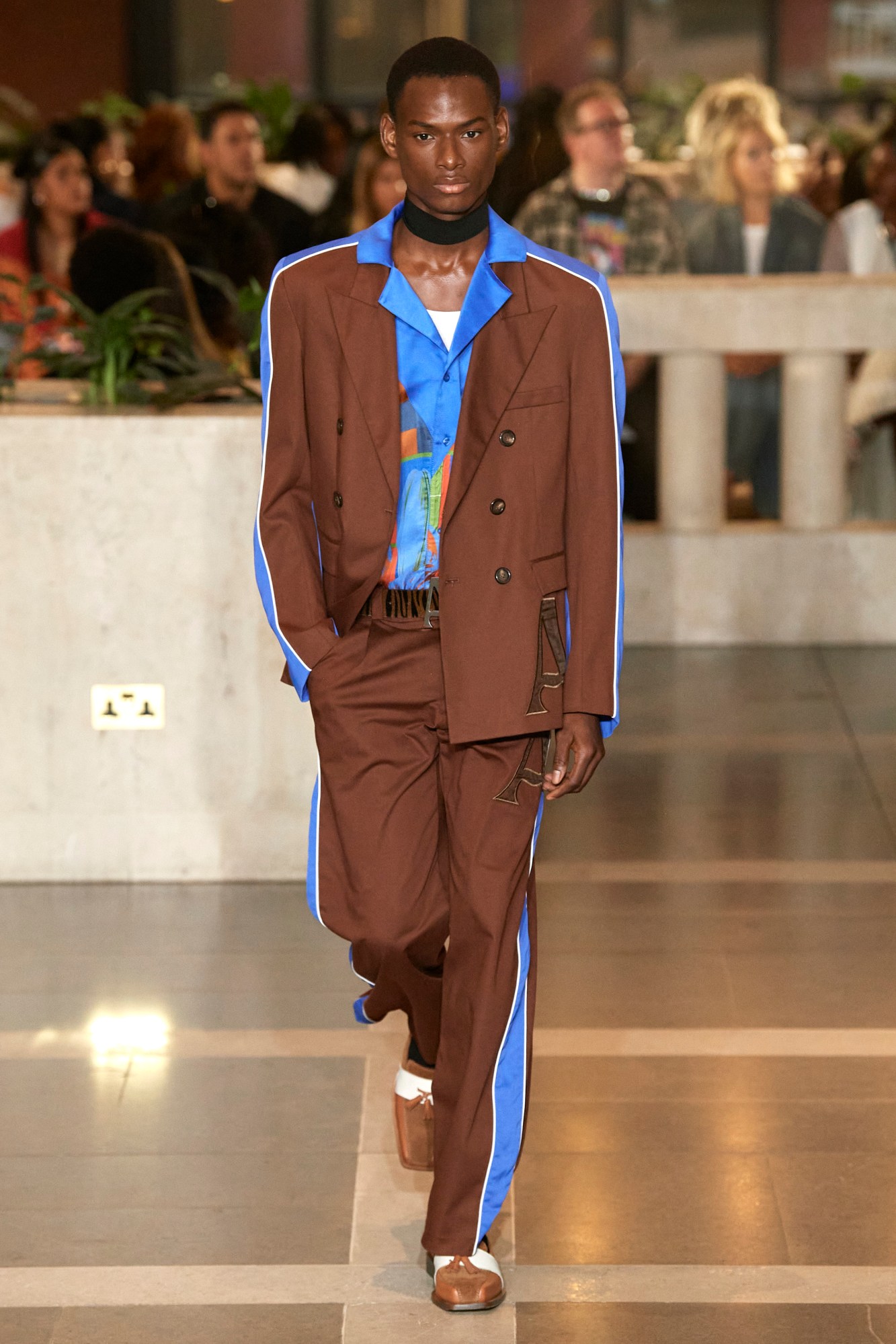
Ahluwalia
Have you heard of Baya Mahieddine, the Algerian artist whose work inspired Picasso? Or Madhubala, the Bollywood screen star and icon who was a key part of Indian cinema’s rise to the global stage? You may have at least heard of Marsha P. Johnson, the drag queen and activist who was a key figure of the Stonewall uprising, a moment which was the cornerstone of modern day Pride. All these women are ones that are often forgotten about in the classroom but Ahluwalia SS24, taking place within The British Library – a nod to doing the research to bring these women’s stories to light – and titled “Acknowledgements”, was a celebration of them and other unsung heroes of colour past and present, finally giving them their flowers.
Literally! Botanical prints adorned a brightly hued two-piece adorning Adwoa Aboah as she opened the show, as well as growing along the embroidered hems of shirting and layered into surrealistic design – like the paintings of Baya Mahieddine – knits and denims. Bright tones of magenta, orange, blue and red popped alongside earthy browns on men’s suiting while silk viscose skirts, dresses and jumpsuits featured slashes weaving up the sides and were dotted with embellishments. Then button down shirts were adorned with the faces and works of those Priya wished to memorialise. As usual, the cultures that are inherent to her identity were apparent too, from the drapings of silk on scoop neck gowns reminiscent of saris, to the Nigerian-style patterns in sunset hues on polos and knee-length shorts. Then, ‘A’ motifs branded zebra striped belts or subtly formed the heel of sleek leather boots – after all, Priya Ahluwalia deserves her flowers too.
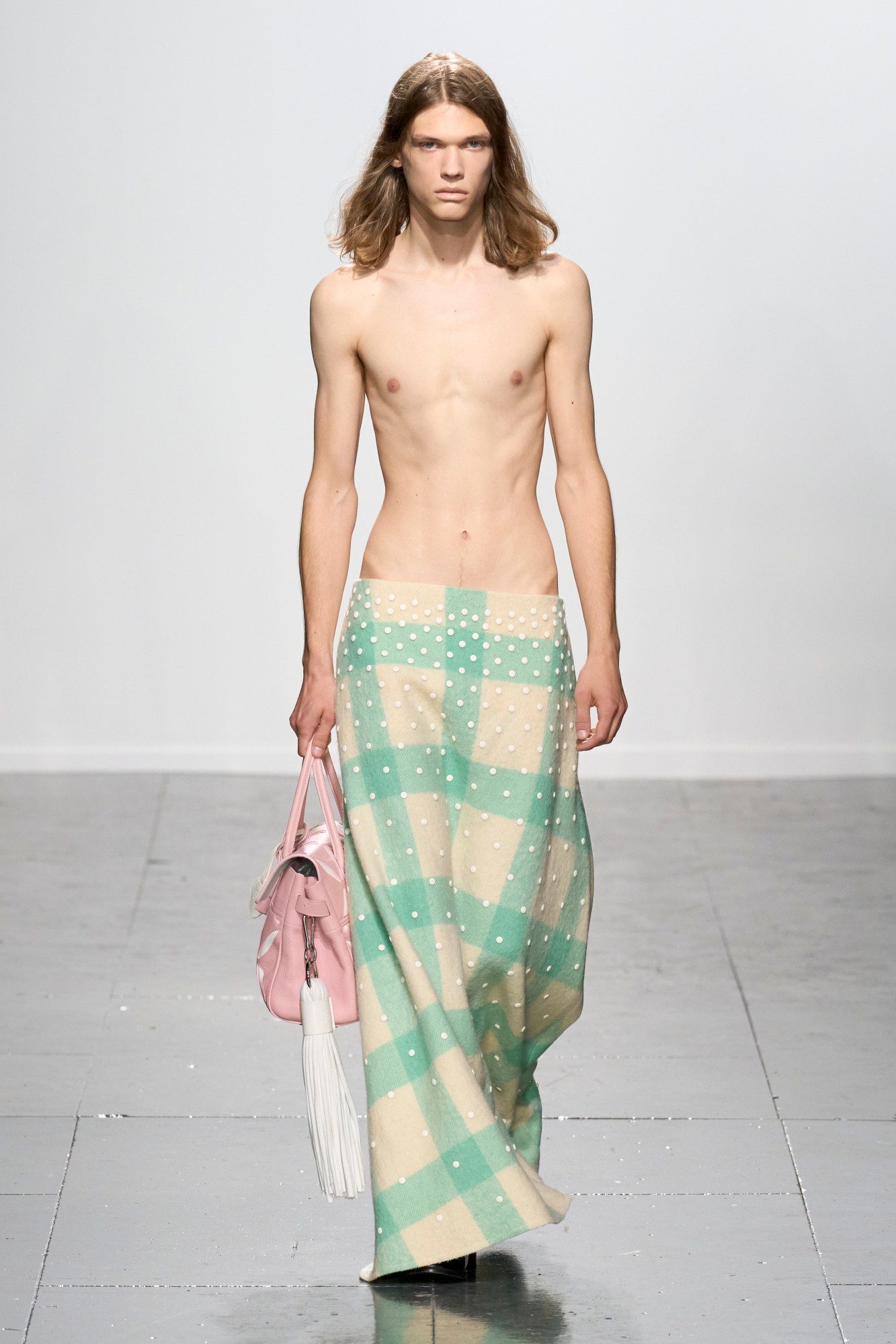
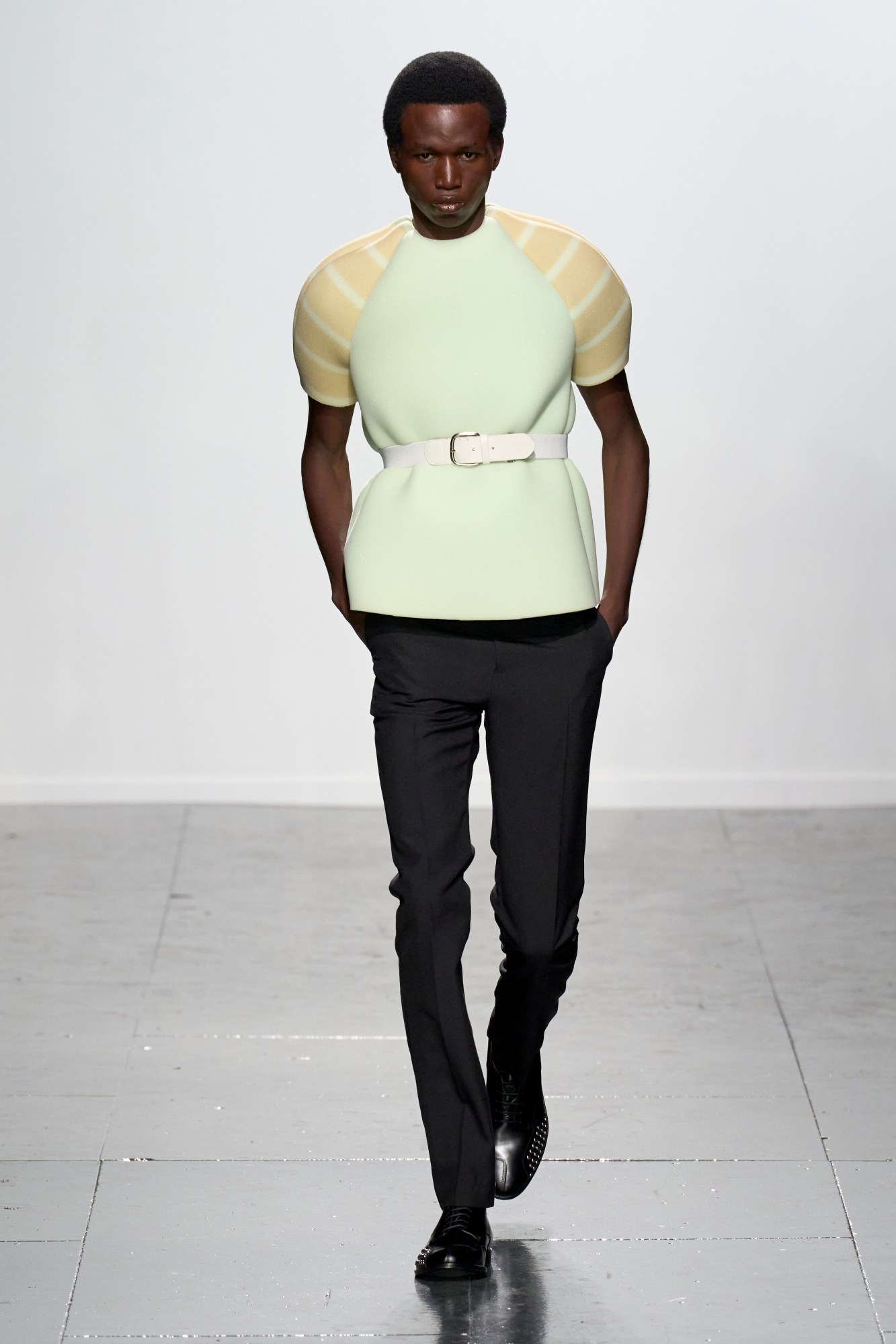
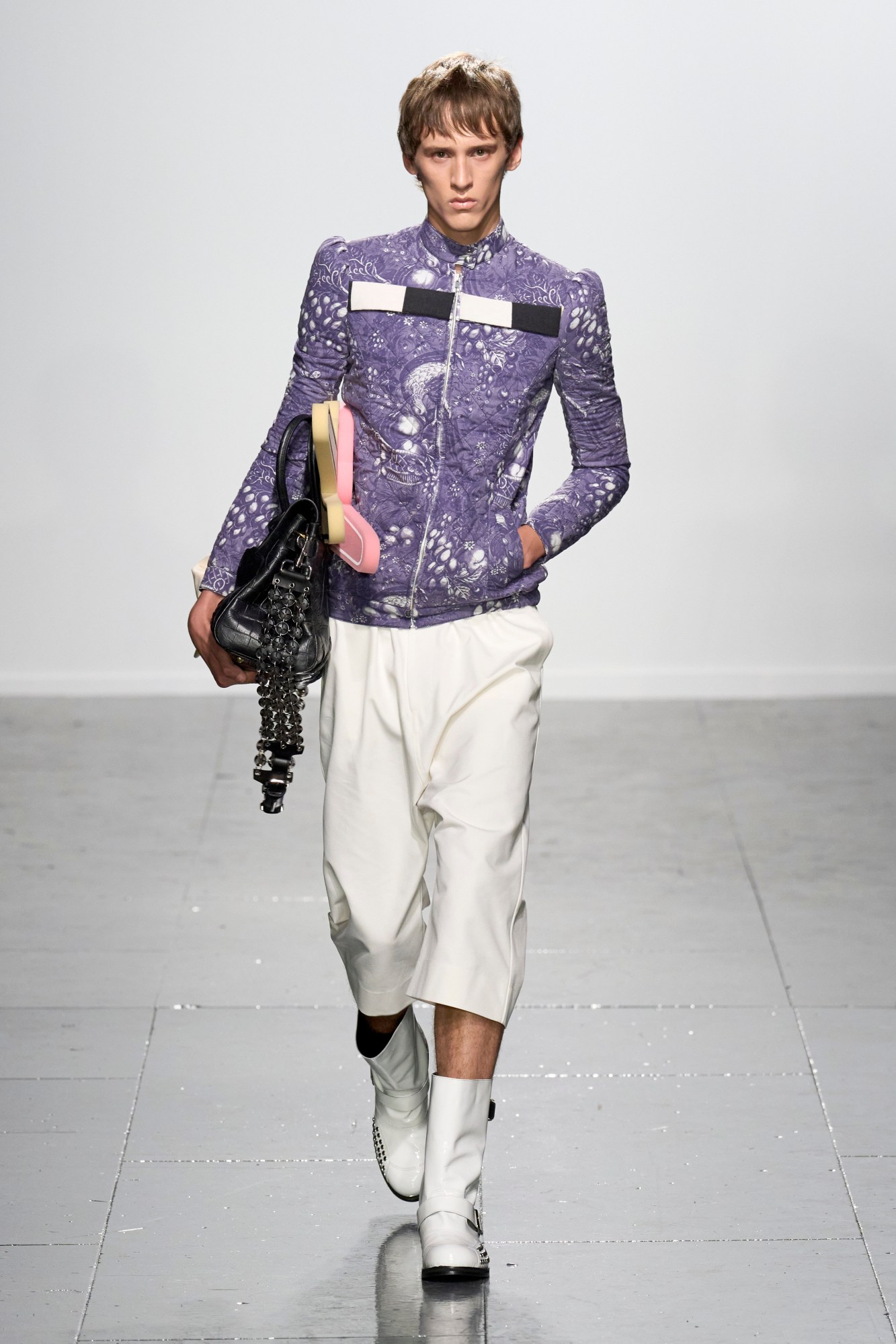
Stefan Cooke
After debuting womenswear in their last collection for SS23, Stefan Cooke and Jake Burt’s return a year later saw them redirect their gaze back to menswear, not that everyone, regardless of pronouns, will want to snap up these gender-transcending garms. Entitled “Away”, many of the looks created the illusion of athletes, or sports fans, making the sobering journey home after the high of a championship win. From a white insignia-emblazoned tee and shorts, to silhouettes inspired by quarterbacks and fashioned from lycra, padding and vintage rugby jerseys – this was a collection that knew the triumphs and defeats, the epic highs and lows of high school football. But this was not the only sport nodded to here. Models wore little more than polka-dot studded, thick tartan wool blankies, either falling from shoulders or wrapped low on the waist like they had just left the lido, stepping into the summer night air. Boys in mini striped shift dresses or v-neck jumpers covered in All-American stars, had built-in celebratory sashes, rendered in luxurious lambswool. Foam fingers were a running motif, whether tucked under the arm alongside baseball caps or the material, bleached in the sun, turned into Polly Pocket-esque tees then cinched at the waist.
The signatures that have made Stefan Cooke pieces so covetable were there too, the studded oxfords, drainpipe trousers, tailored shorts, low-slung, cinched waistlines on heritage jackets and twisting ribbons of fabric on tops were matched on the brand’s new collection with Mulberry, where a handful of pre-loved bags have been turned into one-of-a-kind treasures spliced with Stefan Cooke codes such as chainmail button straps, diamond slashes, wrapping of silk scarves and ribbon detailing and hanging tassel whips made from rugby jerseys. If the frow of UK talents that included Maisie Williams and The Crown’s future Prince Harry, Luther Ford, wasn’t enough confirmation, the link up with the UK’s most artisan leather brand showcased that Stefan Cooke’s focus on craft and intriguing, subversive yet very wearable menswear pieces makes them a standout of the London scene. TG
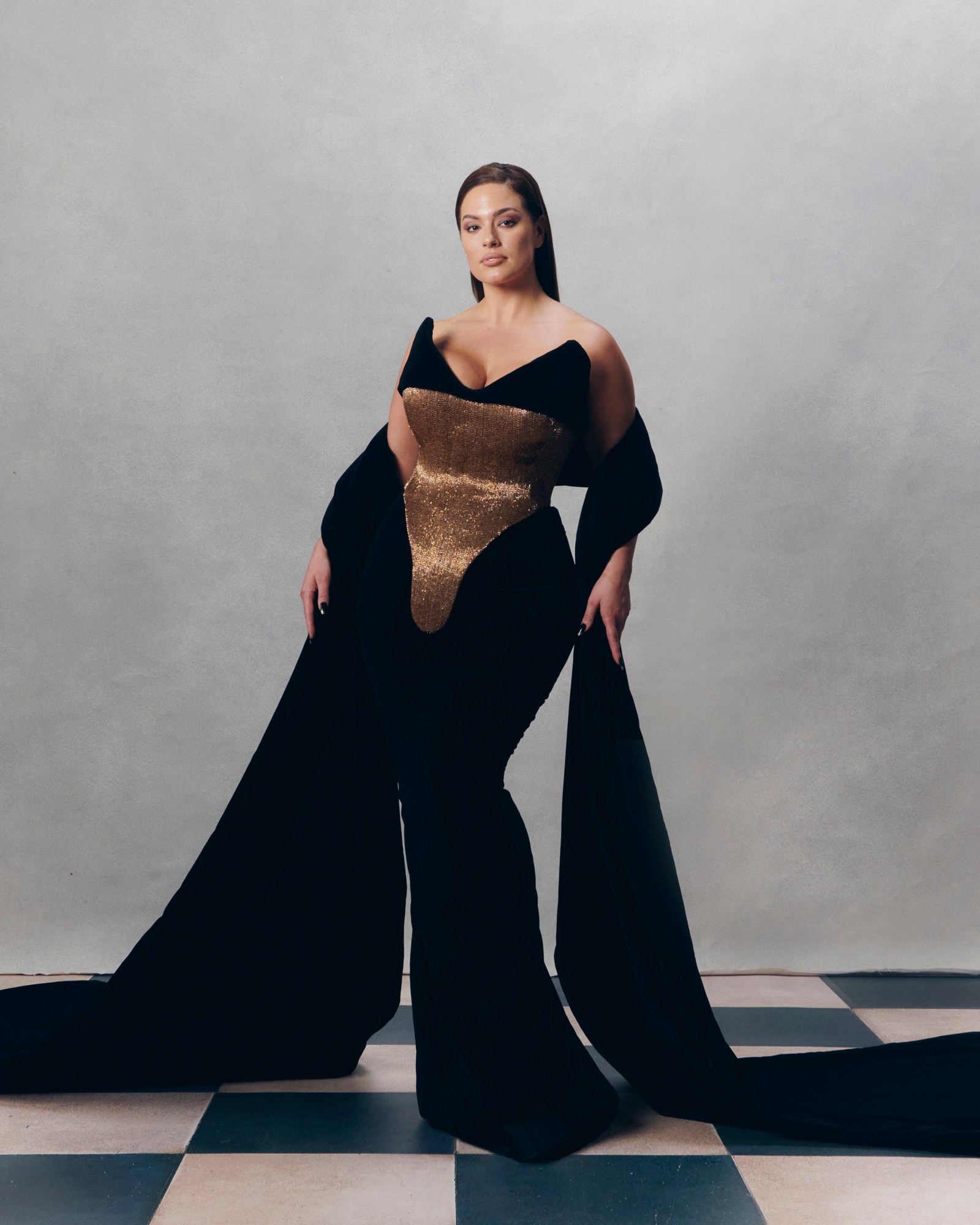
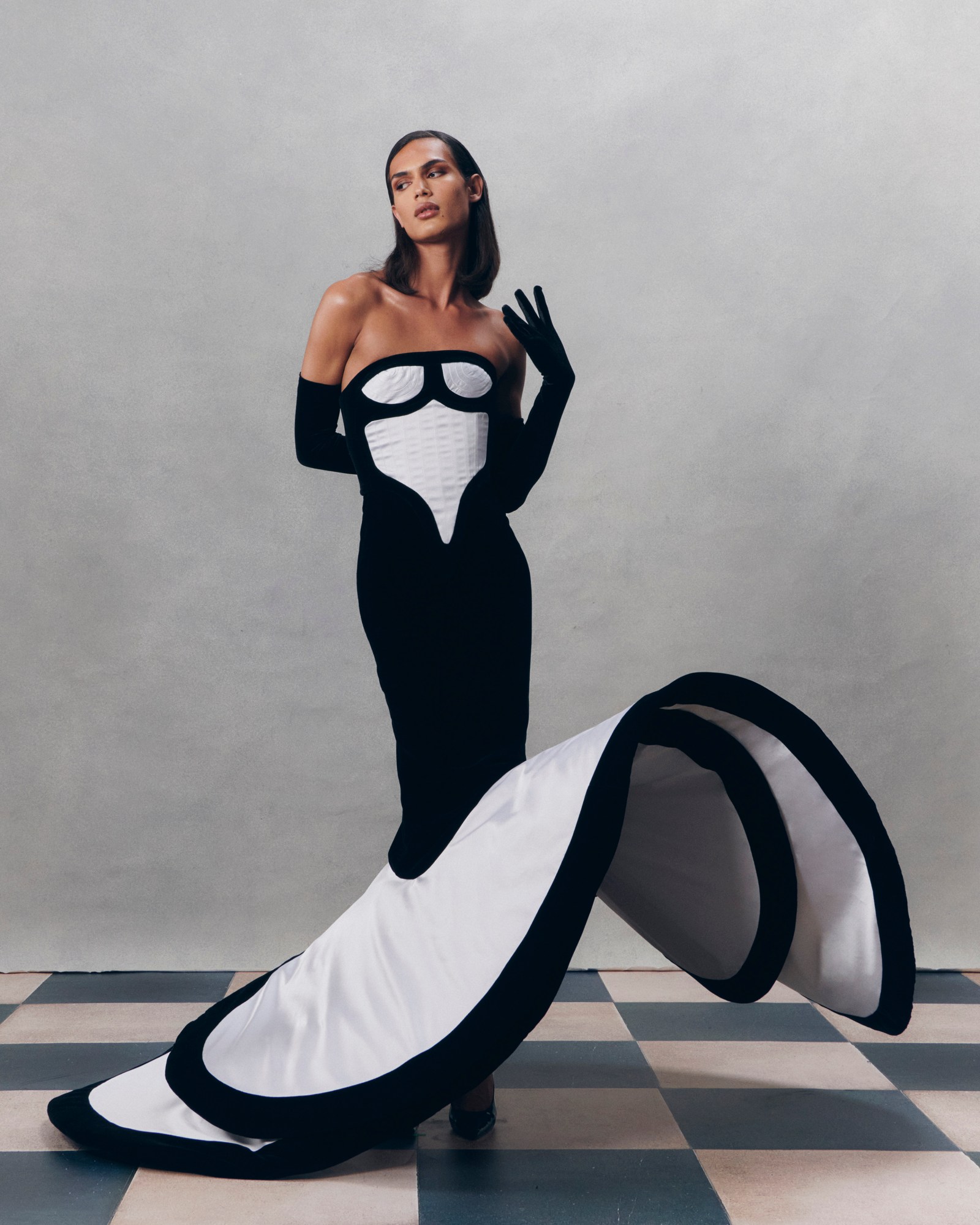

Harris Reed
“I’m a creep, I’m a weirdo, I don’t belong here” sang Cosima; the rising British artist with a jaw-dropping vocal range covered the Radiohead song”Creep” as she soundtracked Harris Reed’s SS24 offering in front of a camp, retro white piano. It’s a fitting lyric, given Harris has built his eponymous brand’s vision as for the outsiders who don’t subscribe to society’s norms, embracing themselves and their differences. And it’s also not fitting, given Harris himself is not really an outsider, with celebrities from Cardi B to Iman desperate to wear one of his famed show-stopping, wide-brimmed pieces, while his beloved work recently led to a job across the channel as creative director of Nina Ricci. The latest celebrity to don Harris’ demi-couture was model Ashley Graham, who walked the runway – set within the echoey, dimly-lit, signal-less basement of the Tate Modern – in black velvet theatre curtains repurposed into a svelty, figure hugging strapless gown with a matching shawl, and topped with a glittering gold corset.
Like a second act to his AW23 collection, Harris continued with the tonal palette of black offset by white detailing and gold accessories for his SS24 collection, entitled “Duet” and inspired by Old Hollywood. The codes he’s become famed for were there – the mermaid tails on opera gowns, moulded to flick upwards reminiscent of a Marilyn moment; the looming structures extending out from the shoulders and torso of eveningwear like fairy wings or a flower petal, and then the new romantic high-waisted flares paired with platform rocker boots. But this collection was a bit more sensual than his previous offerings (the result of Harris in Paris one can only assume!) and more feminine in their silhouettes and shapes, then offset by the heavy, rigid materies. Structured busts and waistlines hovered at a distance from models’ breasts and hips while other chests were covered by sculptural, astrology-themed accessories. Garments made from theatre curtains were purposefully more insecure-seeming than before, ruched or draped in a way that nodded to the naked dress, each just seconds away from falling to the floor and exposing the wearer (one look even paid homage to the 00s bumster, with a slight bit of butt crack spilling out above the ripples of fabric). Harris has always had a flair for the theatrical and dramatic, of course, and this was a collection that looked at the performed femininity and sexuality of the great screen sirens of old through their sartorial choices, and how that can be brought to the gender non-conforming communities of now. TG
